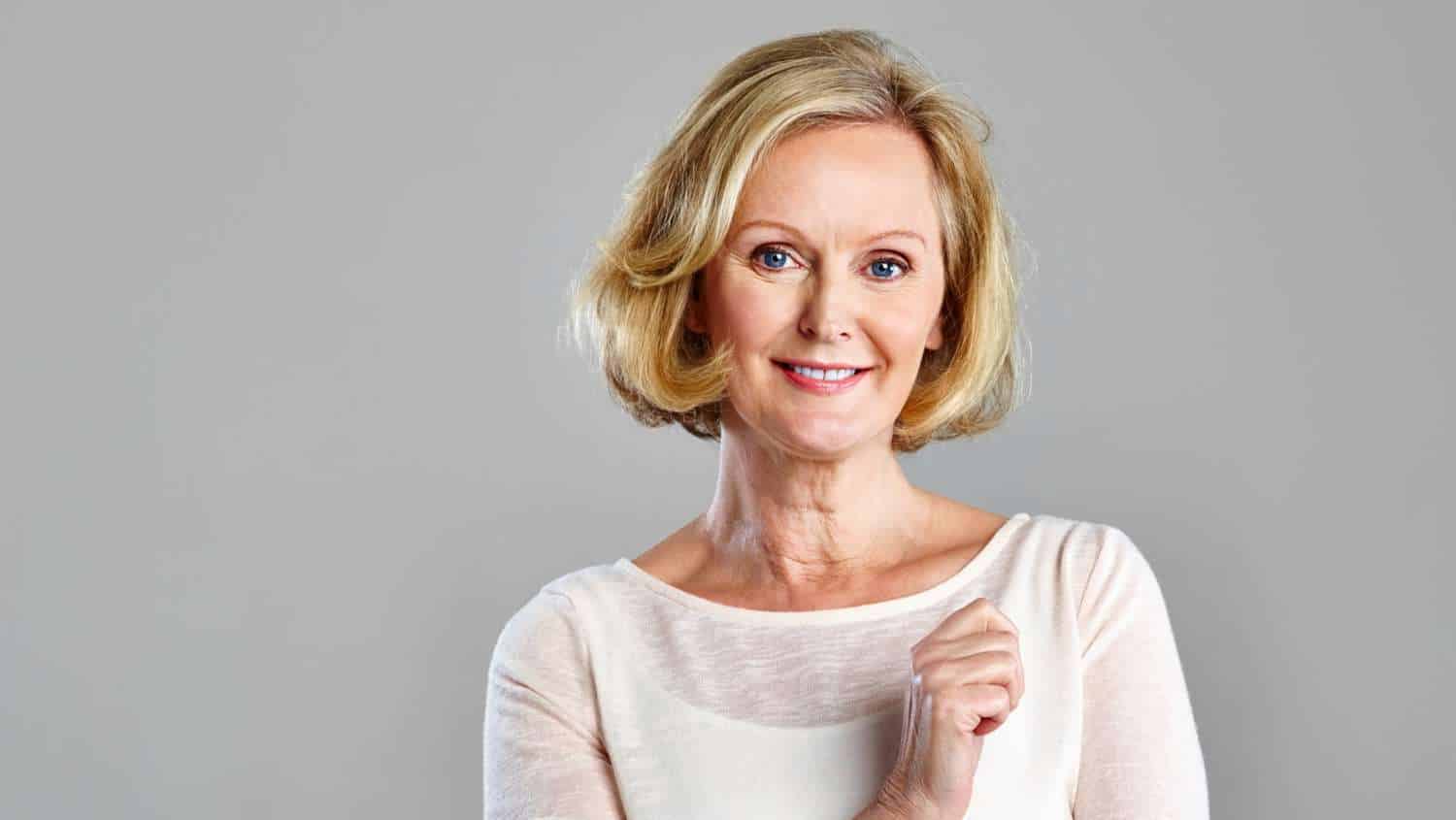
Thematic video
Dating women made me understand menHow women view dating - sorry, that
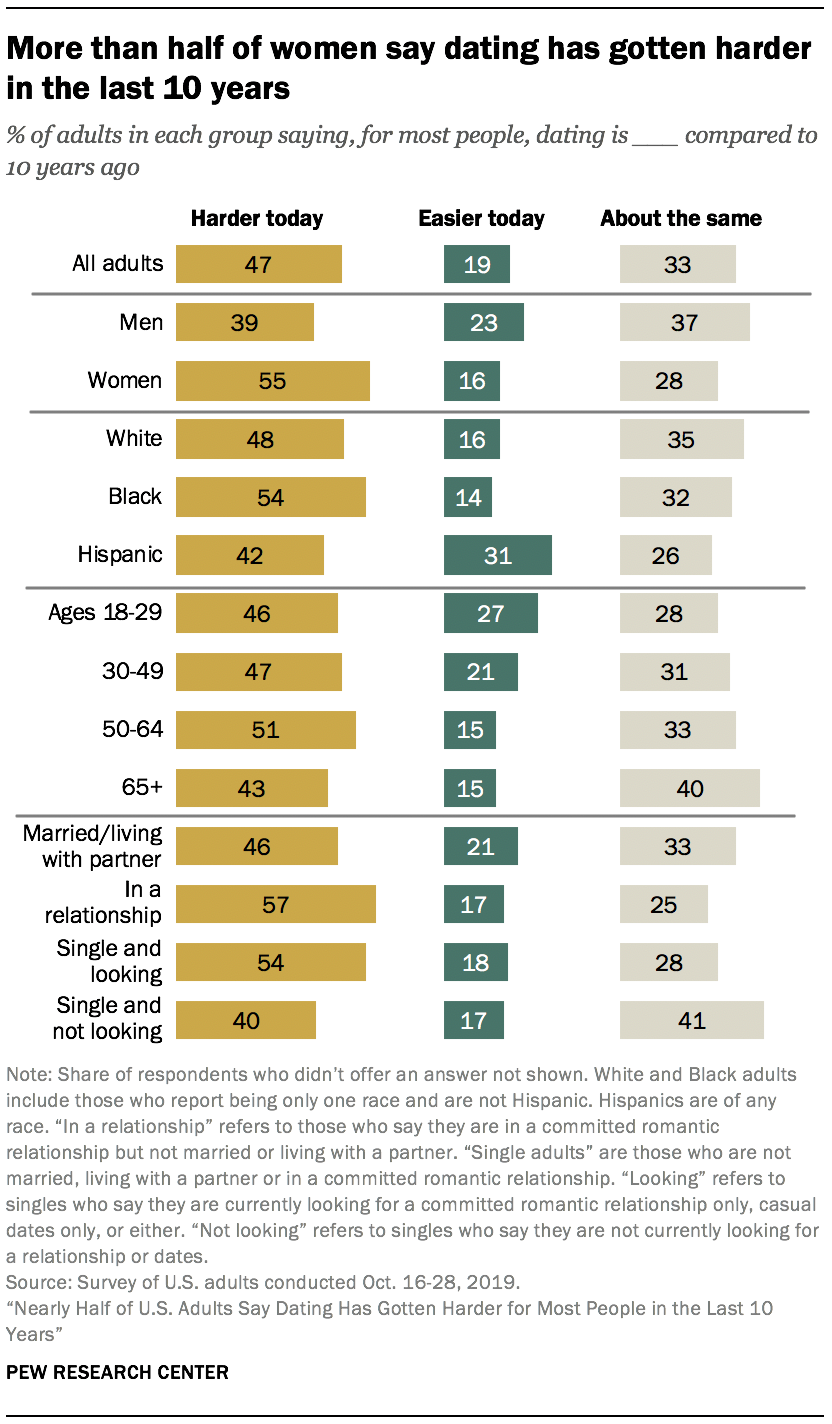 Nearly half of Americans think dating has gotten harder in the last 10 years – especially women, who are much more likely than men to say dating now comes with more risk. Many think the recent increased focus on sexual harassment and assault has made it harder to know how to behave on dates, particularly for men.
Nearly half of Americans think dating has gotten harder in the last 10 years – especially women, who are much more likely than men to say dating now comes with more risk. Many think the recent increased focus on sexual harassment and assault has made it harder to know how to behave on dates, particularly for men.
It’s safe to say that cultural norms around sex and dating have loosened over the years. Still, some practices are considered taboo by many Americans. For example, while most adults say premarital sex is acceptable, only about one-third say the same about open relationships – that is, a committed relationship where both people agree that it is acceptable to date or have sex with other people.
And while options for how to break up with someone have expanded as people are connected through many different platforms, most still say breaking up in person is the way to go.
Almost half of the public says dating has gotten harder in the last 10 years
Nearly half of U.S. adults (47%) say dating is harder today for most people compared with 10 years ago, while a third say it is about the same and 19% say it’s easier today.
Women are much more likely than men to say dating has gotten harder (55% vs. 39%). Black women (62%) are more likely than Hispanic women (50%) to say dating has gotten harder, while 55% of White women say the same. Only 9% of Black women say dating has gotten easier in the last decade, compared with 14% of White women and 27% of Hispanic women.
Overall, 54% of Black, 48% of White and 42% of Hispanic adults say dating has gotten harder. Hispanics (31%) are about twice as likely as White (16%) or Black (14%) adults to say dating is now easier.
In every age group except for those 65 and older, more say dating is harder today than say it’s easier or the same as it was 10 years ago. Adults 65 and older are about as likely to say it’s gotten harder (43%) as they are to say it’s about the same as it was (40%). Adults younger than 50 are more likely than those who are older to say dating has gotten easier in the last 10 years: 27% of those ages 18 to 29 and 21% of those ages 30 to 49 say it has gotten easier, compared with 15% each of those 50 to 64 and 65 and older.
People who are in a committed relationship but not married or living with their partner (57%) or are currently on the dating market (54%) are more likely than their counterparts who are married or living with a partner (46%) or single but not looking for a relationship or dates (40%) to say dating is harder. Among singles who are on the dating market, those who are looking for a committed relationship only are more likely to say dating is harder now (62%) than those who are open to casual dates or only looking for casual dates (50%).
Increased physical and emotional risk is commonly cited as a reason dating has gotten harder; many say technology has made dating easier
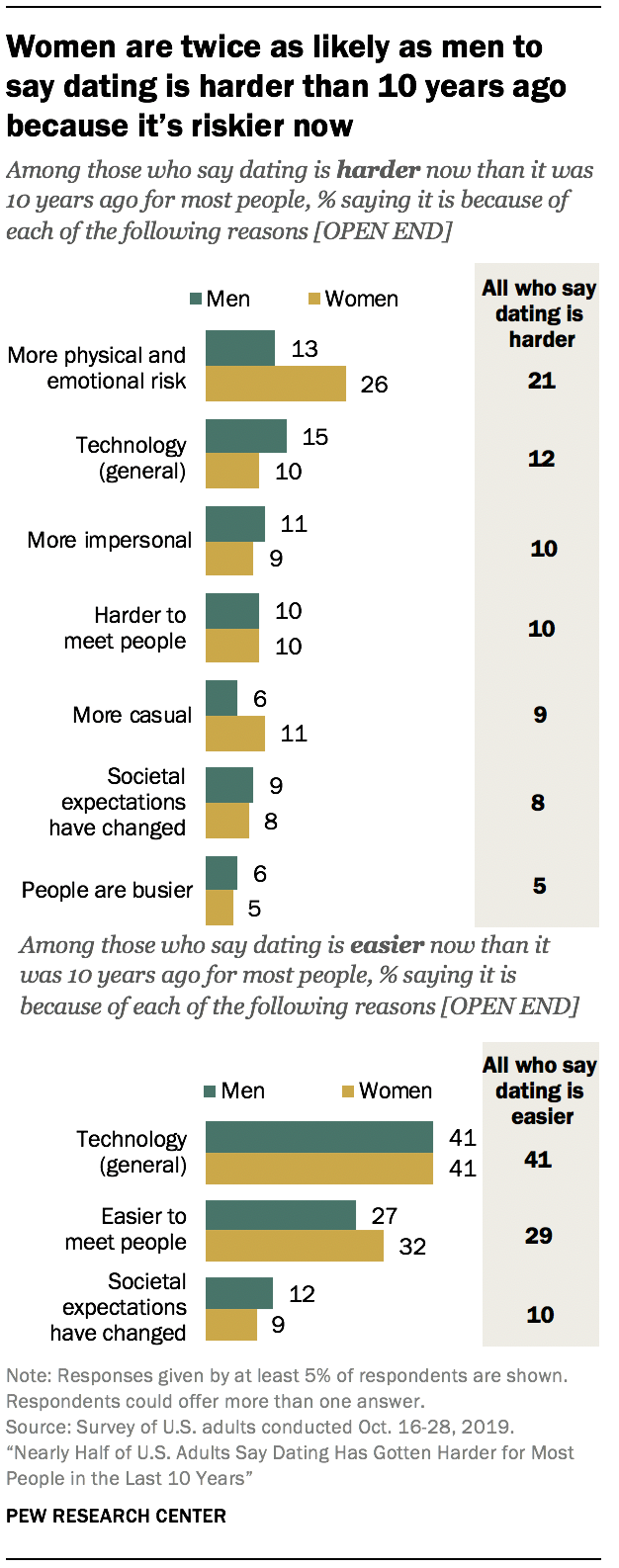 Among the 47% of Americans who say dating is harder now than it was 10 years ago, the increased risk of dating today – including physical risk as well as the risk of getting scammed or lied to – stands out as the most-often-cited reason why dating is harder (21% cite this). Roughly one-in-ten point to technology (12%), the idea that dating has become more impersonal (10%) or that it’s harder to meet people now (10%), the more casual nature of dating today (9%), or changing societal expectations, morals or gender roles (8%). A slightly smaller share (5%) blame the difficulty of dating on people being busier these days.
Among the 47% of Americans who say dating is harder now than it was 10 years ago, the increased risk of dating today – including physical risk as well as the risk of getting scammed or lied to – stands out as the most-often-cited reason why dating is harder (21% cite this). Roughly one-in-ten point to technology (12%), the idea that dating has become more impersonal (10%) or that it’s harder to meet people now (10%), the more casual nature of dating today (9%), or changing societal expectations, morals or gender roles (8%). A slightly smaller share (5%) blame the difficulty of dating on people being busier these days.
Women are twice as likely as men (26% vs. 13%) to say increased risk is a reason dating is harder now. They are also more likely than men to say that it’s harder now because dating has become more casual (11% vs. 6%). For their part, men are somewhat more likely to say technology is a reason (15% vs. 10%).
Older adults are more likely to see increased risk as a reason dating is harder now: 23% of those 65 and older and 30% of those 50 to 64 point to increased risk, compared with 16% of 30- to 49-year-olds and 13% of adults younger than 30.
There is no significant difference between those with online dating experience and those who have never used online dating when it comes to whether technology is a reason dating is harder now.
“A lot of people catfish people and pretend to be something they are not.” Woman, 38 years old, married
“…STDs [sexually transmitted diseases] are totally out of control here…” Man, 70, single
“Because there are a lot of crazy people out there and the internet allows that crazy to be masked longer than it used to be.” Woman, 33, married
“Apps encourage snap judgments so initial contact is often not even made.” Man, 53, single
“[Cellphones] and Facebook compete with quality time.” Man, 60, single
“Cultural norms have changed, harder to find people who want relationships and not just ‘hooking up.’” Woman, 20, living with partner
“If you are a Christian, too much is expected of you to do against your belief.” Woman, 88, single
“People are more independent now.” Woman, 75, married
“Romanticism is pretty much dead. We live in a culture where having feelings for someone is undesirable. To be vulnerable with someone is taboo.” Woman, 25, in a committed relationship
“Relationship, gender and sexuality roles have been upended and no one knows what they’re doing.” Man, 35, married
When it comes to why dating has gotten easier in the last 10 years, technology tops the list. Among the 19% of respondents who say dating is now easier, about four-in-ten (41%) say technology is a reason. This is followed by 29% who say it is easier to meet people now and 10% who say that changing societal expectations, morals and gender roles have made it easier to date.
Men and women who say dating has gotten easier give similar reasons for this. There are also no significant differences by age.
Technology is far more likely to be mentioned by those who say dating has gotten easier than by those who say it’s gotten harder. About two-thirds (66%) of those who say dating is now easier either point to technology in general or otherwise mention technology in their answer, compared with 31% of those who say dating is now harder.
“Because [of] online dating you can meet people without leaving your house.” Woman, 48 years old, in a committed relationship
“Because [there] are tons of dating websites and apps that are geared towards different [kinds] of people.” Man, 51, married
“10 years ago you actually had to go out and meet people; now you can find someone from the comfort of your own home.” Woman, 30, single
“Males and females tend to do more socializing in groups today than in the more distant past. This makes it easier to meet.” Man, 76, married
“Dating apps are now the norm. It seems like the answer to the ‘how did you two meet’ question is more often than not met with the name of a dating app.” Woman, 25, living with a partner
“For queer people it is easier to be open and find potential partners.” Woman, 26, living with a partner
“Parents are not as strict these days.” Woman, 69, single
“The ‘rules’ that used to apply are more relaxed now. It’s easier and more acceptable for women to initiate contact.” Woman, 58, single
“Lowered moral standards.” Man, 72, married
A plurality says online dating has had a neither positive nor negative effect on dating and relationships
When it comes to the impact online dating sites and apps have had on the broader landscape of dating and relationships these days, half of adults say it has been neither positive nor negative. The remainder of the public is divided: 22% say online dating has had a mostly positive impact while 26% say it has been mostly negative.
Those who have experience with online dating (29%) are more likely than those who don’t (21%) to say online dating has had a positive impact on dating and relationships overall, although minorities in both groups say this is the case. Similar shares of those who have online dated and those who haven’t say the impact has been negative.
Those who met their current partner online are much more likely than those who met their partner in some other way to say online dating’s impact has been positive (40% vs. 21%).
Most say it’s harder for men to know how to behave on dates in the era of the #MeToo movement
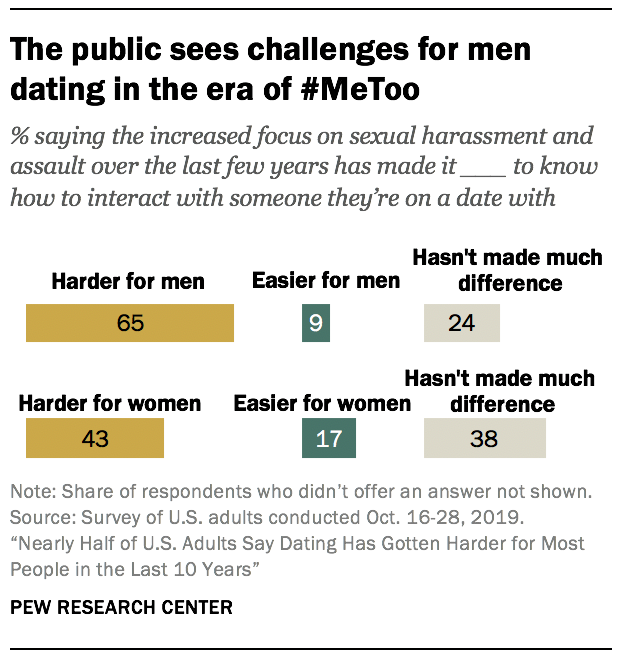 Most Americans say it has become harder for men to know how to interact with someone they’re on a date with due to the increased focus on sexual harassment and assault over the last few years. Some 65% say this, while 9% say this focus has made it easier for men and 24% say it hasn’t made much difference. Opinions are more mixed when it comes to the impact on women. Fewer than half (43%) say it is harder for women to know how to behave on dates as a result of the attention paid to sexual harassment and assault, while 17% say this has made it easier for women and 38% say it hasn’t made much of a difference.
Most Americans say it has become harder for men to know how to interact with someone they’re on a date with due to the increased focus on sexual harassment and assault over the last few years. Some 65% say this, while 9% say this focus has made it easier for men and 24% say it hasn’t made much difference. Opinions are more mixed when it comes to the impact on women. Fewer than half (43%) say it is harder for women to know how to behave on dates as a result of the attention paid to sexual harassment and assault, while 17% say this has made it easier for women and 38% say it hasn’t made much of a difference.
Men and women see eye to eye on the impact the #MeToo movement has had on women, but men (69%) are more likely than women (61%) to say this increased focus on sexual harassment and assault has made it harder for men to know how to interact – though most in each group agree it has made it harder.
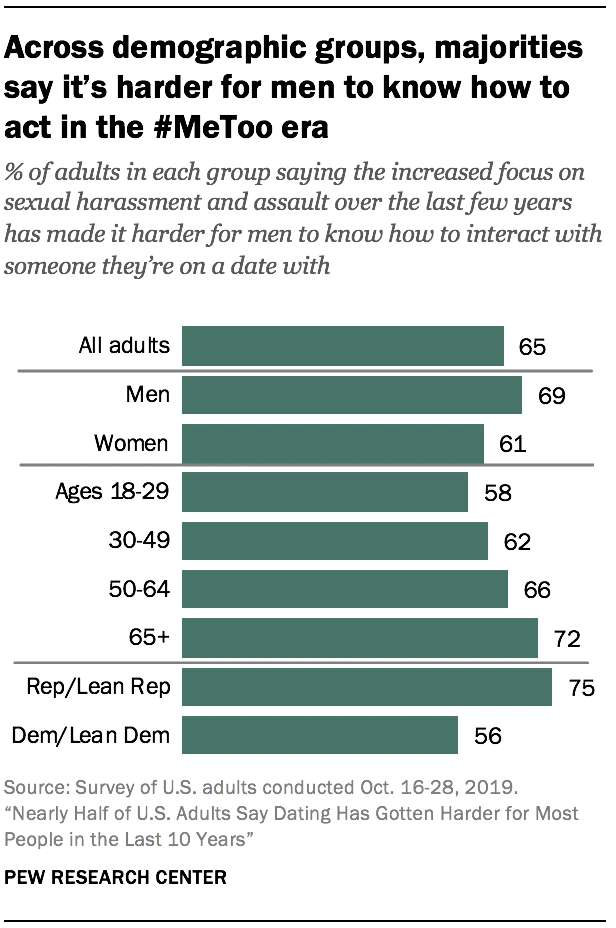 Older people are more likely than younger adults to see challenges for men dating in the era of #MeToo. For example, 72% of those ages 65 and older say it is now harder for men to know how to interact with someone they’re on a date with, compared with 66% of those 50 to 64, 62% of those 30 to 49 and 58% of those 18 to 29. Older men are particularly likely to say this – 75% of those 50 and older say it is now harder for men to know how to behave, compared with 63% of men younger than 50 and 58% of younger women. Some 63% of women age 50 and older say the same.
Older people are more likely than younger adults to see challenges for men dating in the era of #MeToo. For example, 72% of those ages 65 and older say it is now harder for men to know how to interact with someone they’re on a date with, compared with 66% of those 50 to 64, 62% of those 30 to 49 and 58% of those 18 to 29. Older men are particularly likely to say this – 75% of those 50 and older say it is now harder for men to know how to behave, compared with 63% of men younger than 50 and 58% of younger women. Some 63% of women age 50 and older say the same.
Older adults are also more likely to say it is now harder for women to know how to behave with someone they’re on a date with, but men and women have roughly the same opinions across age groups.
Republicans are more likely than Democrats to say the recent focus on sexual harassment and assault has made it harder for both men (75% vs. 56%) and women (49% vs. 38%) to know how to act. Republican men are particularly likely to say it has become harder for men (81%, compared with 69% of Republican women). Among Democrats, men and women are equally likely to say this.
Older Democrats are more likely than younger Democrats to say it is harder for men to know how to act in the era of #MeToo (61% of Democrats ages 50 and older compared with 53% of Democratic adults younger than 50). However, there is no significant difference by age among Republicans about whether it has become harder for men.
Among single people, those who are currently on the dating market (64%) are more likely than singles who are not looking for a relationship or dates (56%) to say that it is harder for men to know how to act now.
Whether or not someone has experienced any kind of harassing behaviors from someone they dated or were on a date with (such as being pressured for sex or someone they were dating spreading rumors about their sexual history) does not appear to influence views on this topic. This is true among both men and women.
Most say premarital sex is acceptable behavior, while sex on a first date and open relationships are taboo for most people
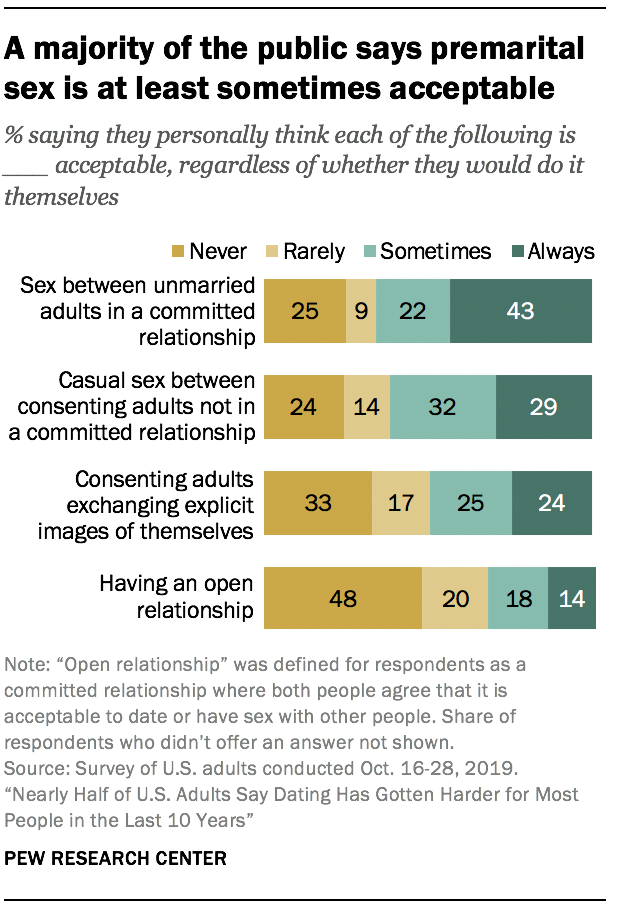 Roughly half of adults (48%) say having an open relationship – that is, a committed relationship where both people agree that it is acceptable to date or have sex with other people – is never acceptable, regardless of whether they would do it themselves. An additional 20% say it is rarely acceptable and 32% say it is acceptable either sometimes or always.
Roughly half of adults (48%) say having an open relationship – that is, a committed relationship where both people agree that it is acceptable to date or have sex with other people – is never acceptable, regardless of whether they would do it themselves. An additional 20% say it is rarely acceptable and 32% say it is acceptable either sometimes or always.
Other sexual and dating practices are generally seen as more acceptable, at least in some circumstances. About half (49%) say it is at least sometimes acceptable for consenting adults to exchange sexually explicit images of themselves. Most say casual sex between consenting adults not in a committed relationship (62%) and sex between unmarried adults who are in a committed relationship (65%) can be acceptable. Still, about a quarter of the public sees casual sex (24%) or premarital sex (25%) as never acceptable.
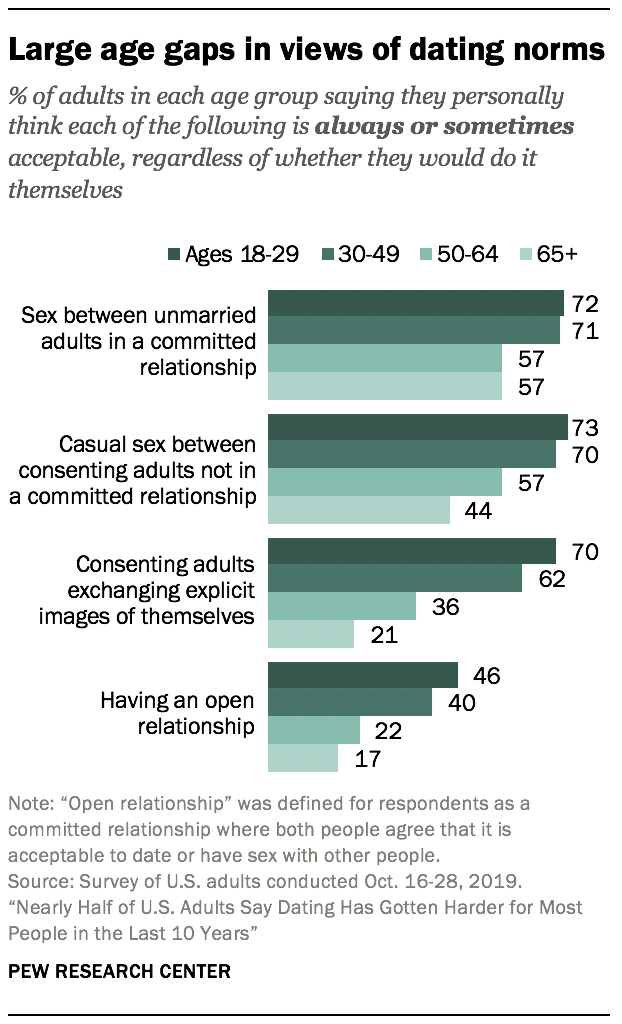 Adults of different ages view some of these norms in drastically different ways. When it comes to exchanging sexually explicit photos of oneself, young adults ages 18 to 29 are more than three times as likely as those 65 and older to say this is always or sometimes acceptable (70% compared with 21%).
Adults of different ages view some of these norms in drastically different ways. When it comes to exchanging sexually explicit photos of oneself, young adults ages 18 to 29 are more than three times as likely as those 65 and older to say this is always or sometimes acceptable (70% compared with 21%).
Some 46% of 18- to 29-year-olds and 40% of 30- to 49-year-olds say open relationships are acceptable. By contrast, 22% of 50- to 64-year-olds and 17% of those 65 and older say the same.
While the differences are less dramatic, younger adults are also significantly more accepting of premarital sex and casual sex than their older counterparts. Still, majorities of all age groups say that premarital sex is acceptable.
While men and women see eye to eye on premarital sex, men are much more likely than women to find casual sex (70% vs. 55%) and exchanging explicit images of oneself (57% vs. 41%) acceptable always or sometimes. And while a minority of both men and women say open relationships are acceptable, men (35%) are more accepting than women (29%).
Adults with a college degree or more education are more likely than those with some college experience or less to see each of these items as acceptable. The same is true of Democrats and those who lean to the Democratic Party compared with Republicans and Republican leaners. In fact, Democrats are twice as likely to say open relationships are acceptable (42%, compared with 21% of Republicans).
Large gaps also exist between those who identify as lesbian, gay or bisexual and those who identify as straight. LGB adults were the only demographic group studied in which a majority say that having an open relationship is always or sometimes acceptable (61%, compared with 29% of straight adults). A large majority also says that two consenting adults exchanging sexually explicit images of themselves is acceptable at least sometimes (74% of LGB adults vs. 47% of their straight counterparts). Majorities of both groups say that premarital and casual sex are acceptable, but LGB adults again are significantly more likely to say this.
When it comes to the acceptability of each of these dating norms, the differences between Democrats and Republicans and between LGB and straight adults remain even after controlling for demographic differences between the groups, such as age, race and religiosity.
Most say it’s usually necessary to ask for permission before kissing someone on a date
Respondents were also asked whether it was acceptable to kiss someone on a date without asking for permission first. Most (60%) say this is rarely or never acceptable (including 36% who say it is never acceptable), while 39% say it can be acceptable at least sometimes.
Men and women and people of all ages are about equally likely to say kissing without asking permission is never acceptable. Black adults (57%), however, are much more likely to say this is never acceptable, compared with 31% of White and 39% of Hispanic adults. Democrats and those with some college or less education are also more likely to think that kissing without asking permission is never acceptable.
Relatively few adults say having sex on a first date is acceptable
There is some disagreement about what sort of behavior is appropriate on a first date. While nearly all of the public thinks it’s acceptable at least sometimes to hug on a first date, there is some gray area when it comes to kissing, and relatively few say having sex is acceptable on a first date (regardless of whether they would do it themselves).
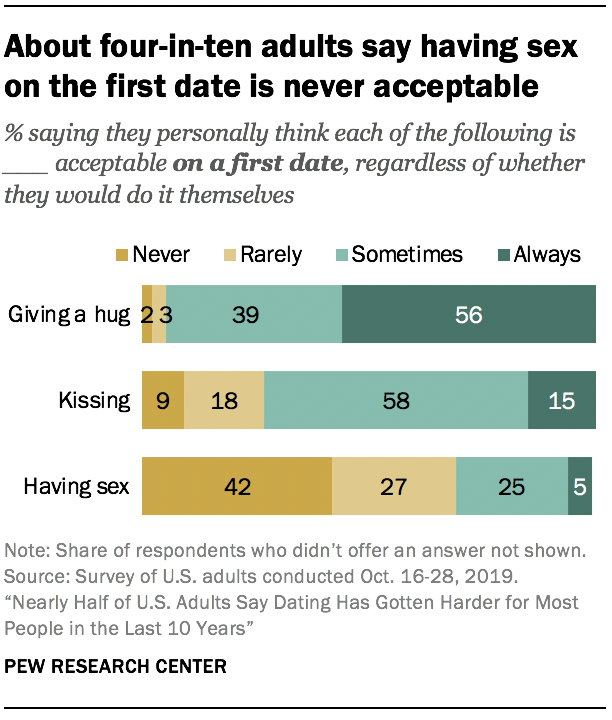 Fully 95% of adults say that giving a hug would be acceptable always or sometimes on a first date, including 56% who say it is always acceptable. Most also say kissing is acceptable (72%), but far fewer say this is always acceptable (15%).
Fully 95% of adults say that giving a hug would be acceptable always or sometimes on a first date, including 56% who say it is always acceptable. Most also say kissing is acceptable (72%), but far fewer say this is always acceptable (15%).
When it comes to sex on the first date, 30% say this is always or sometimes acceptable. Meanwhile 27% say it’s rarely acceptable and 42% say it is never acceptable.
Men are more likely than women to see each of these behaviors as acceptable on a first date, but the gender gap is especially wide when it comes to having sex. About four-in-ten men (39%) say having sex on a first date can be acceptable at least sometimes, compared with 21% of women.
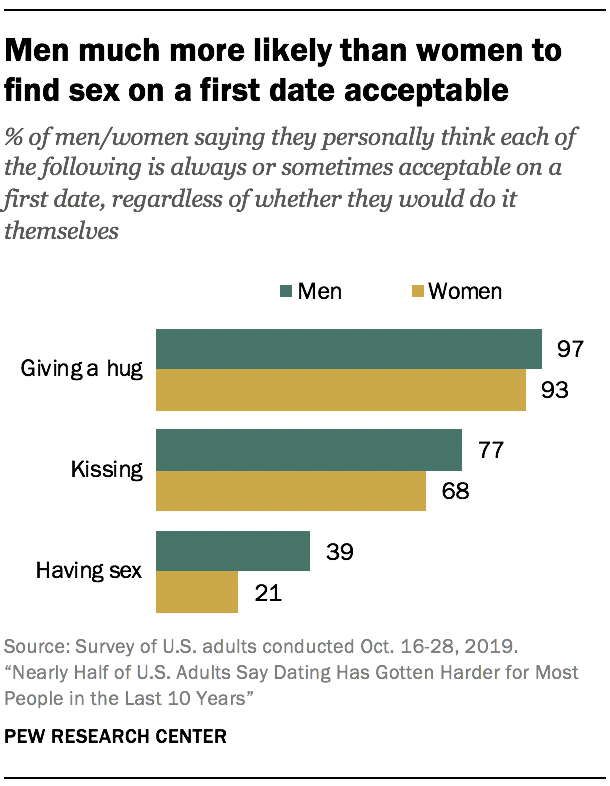 The difference between younger and older Americans is also widest when it comes to sex. While roughly four-in-ten adults ages 18 to 29 (42%) and 30 to 49 (38%) say having sex on a first date is always or sometimes acceptable, the shares are much lower among 50- to 64-year-olds (21%) and those 65 and older (13%). Adults younger than 50 are also more likely than their older counterparts to say that giving a hug and kissing on a first date are acceptable, but the differences are much smaller.
The difference between younger and older Americans is also widest when it comes to sex. While roughly four-in-ten adults ages 18 to 29 (42%) and 30 to 49 (38%) say having sex on a first date is always or sometimes acceptable, the shares are much lower among 50- to 64-year-olds (21%) and those 65 and older (13%). Adults younger than 50 are also more likely than their older counterparts to say that giving a hug and kissing on a first date are acceptable, but the differences are much smaller.
Democrats and Republicans mostly see eye to eye on whether hugging and kissing are acceptable on a first date, but Democrats (38%) are more likely than Republicans (21%) to say having sex is acceptable at least sometimes.
LGB adults are more likely than their straight counterparts to say kissing on a first date is acceptable, though large shares in each group say this (79% vs. 72%). And LGB adults much more likely than those who are straight to say the same about having sex (52% vs. 27%).
Breaking up with someone through technology, ‘ghosting’ are largely seen as unacceptable
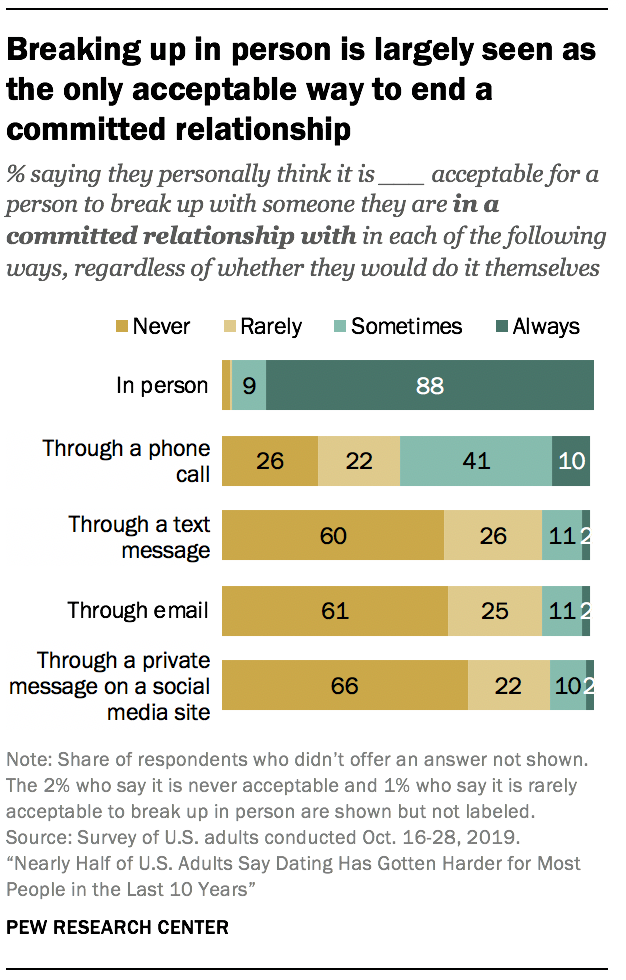 Though people have been ending romantic relationships in impersonal ways at least since the advent of the Dear John letter, the countless new ways of communicating with romantic partners have brought up concerns that breaking up through technology may become the new norm. But despite the role technology plays in dating and relationships these days, most people say breaking up in person is the only acceptable way to do it – even with casual dating partners.
Though people have been ending romantic relationships in impersonal ways at least since the advent of the Dear John letter, the countless new ways of communicating with romantic partners have brought up concerns that breaking up through technology may become the new norm. But despite the role technology plays in dating and relationships these days, most people say breaking up in person is the only acceptable way to do it – even with casual dating partners.
Nearly all U.S. adults (97%) say it is at least sometimes acceptable to break up in person with someone they are in a committed relationship with, including 88% who say this is always acceptable. By contrast, about half (51%) say it can be acceptable to break up through a phone call at least sometimes, with only 10% saying this is always acceptable. Much smaller shares say it is at least sometimes acceptable to break up through a text message (14%), email (14%) or a private message on a social media site (11%). In fact, majorities say each of those methods of ending a committed relationship are never acceptable.
Men are somewhat more likely than women to say ending a committed relationship over the phone can be acceptable (55% vs. 47%), but otherwise men and women mostly agree on these break-up norms.
Adults younger than 50 are more likely than those who are older to say it’s at least sometimes acceptable to break up through a phone call (57% vs. 43%), text message (16% vs. 11%) or social media private message (15% vs. 8%). There is no difference by age in whether it is acceptable to break up via email.
Most agree that breaking up in person is preferable even when it’s only a casual relationship
 When asked the same question, but about a person breaking up with someone they are casually dating, the results are strikingly similar to those about ending a committed relationship.
When asked the same question, but about a person breaking up with someone they are casually dating, the results are strikingly similar to those about ending a committed relationship.
Again, the vast majority (97%) say it’s at least sometimes acceptable to break up in person. Breaking up with a casual partner over the phone is seen as somewhat more acceptable than ending a committed relationship over the phone (64% vs. 51%), but still only a small share say this is always acceptable.
About one-in-five adults say it is always or sometimes acceptable to break up with a casual partner by text message (22%), email (20%) or social media private message (20%).
The patterns of gender and age differences are largely the same for breaking up with a casual partner and ending a committed relationship.
Only about one-in-ten single-and-looking adults say they would ‘ghost’ someone they didn’t want to see again
Despite apocryphal warnings of “ghosting,” or suddenly stopping answering phone calls or messages without explanation, few people on the dating market say they would do this after a first date. Only 8% say they would do this, compared with 40% who say they would contact the person and let them know they didn’t want to go out again. About half (52%) say they wouldn’t proactively contact the person but would let them know they weren’t interested if the person tried to get in touch.
Single-and-looking men are split on whether they would contact the person after the first date and let them know (47%) or wait for the other person to contact them before letting them know (also 47%). Meanwhile, women on the dating market are much more likely to say they would only let the other person know if they got in touch first (59%) than say they would reach out to let the person know (30%).
Young singles on the dating market – those ages 18 to 29 – are more likely than their older counterparts to say they would take the direct approach by proactively contacting the person. About half in this age group (49%) say this, compared with 37% of daters ages 30 to 49 and 34% of those 50 and older.
Swipe Right®
Get the app!
Single people, listen up: If you’re looking for love, want to start dating, or just keep it casual, you need to be on Tinder. With over 55 billion matches made, it’s the place to be to meet your next best match. Let’s be real, the dating landscape looks very different today, as most people are meeting online. With Tinder, the world’s most popular free dating app, you have millions of other single people at your fingertips and they’re all ready to meet someone like you. Whether you’re straight or in the LGBTQIA community, Tinder’s here to bring you all the sparks.
There really is something for everyone on Tinder. Want to get into a relationship? You got it. Trying to find some new friends? Say no more. New kid on campus and looking to make the most of your college experience? Tinder U’s got you covered. Tinder isn’t your average dating site — it’s the most diverse dating app, where adults of all backgrounds and experiences are invited to make connections, memories, and everything in between.
We get it: Dating isn't exactly easy these days. In 2019, we're busy, we're stressed, and we're constantly faced with a myriad of distractions that can make wading into the dating pool seem like getting drowned in a raging sea. While some folks are opting out altogether, the brave souls who want to meet someone are faced with an increasing number of ways to do so. Dating apps? Matchmakers? Speed dating? Introducing yourself to a cutie at the bar? Many of us are exhausted just thinking about it. So yes, dating is a lot, and it's clear we could all use a little insight (and commiseration) about the whole process. That's why Shondaland decided to take a 360-degree look at the state of dating today, from the struggles and the successes to how we're meeting new people — dating apps, DMs, and more — or how we're sometimes, well, not.
If you’re dating in 2019, chances are you’re using an app. Maybe you’re using multiple apps. And that process, as many of us know, can be, well, a drag. Shondaland.com wants to help ease the pain with a deep dive into the nitty gritty of online-dating profiles. Our hope? To not only make your profiles smarter, sexier and shinier, but to ensure that when and if you do get a match, it's going to be the kind of person you actually want to go on a date with. Thus, we matched three women with three seasoned online-matchmaking experts to find out: What makes the perfect profile?
The State of the Date

Yes, There Is A "Good" Way to Break Up, According to Experts
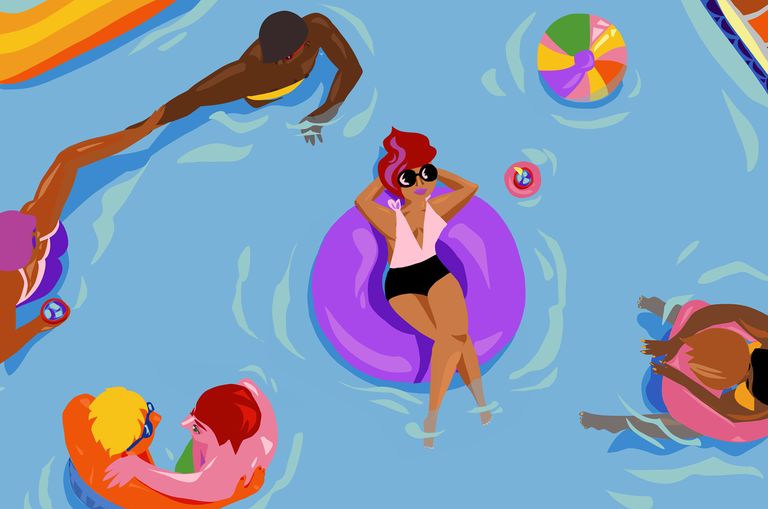
Why I Didn't Waste My Summer Dating
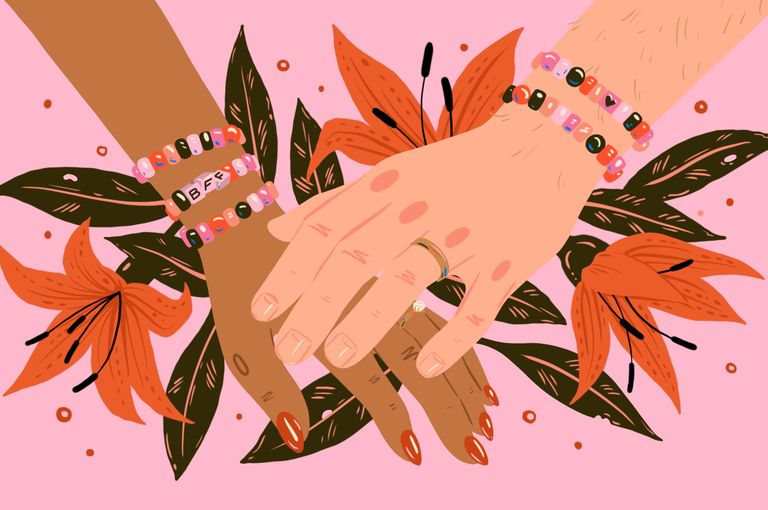
Please Don't Call Your Spouse Your Best Friend
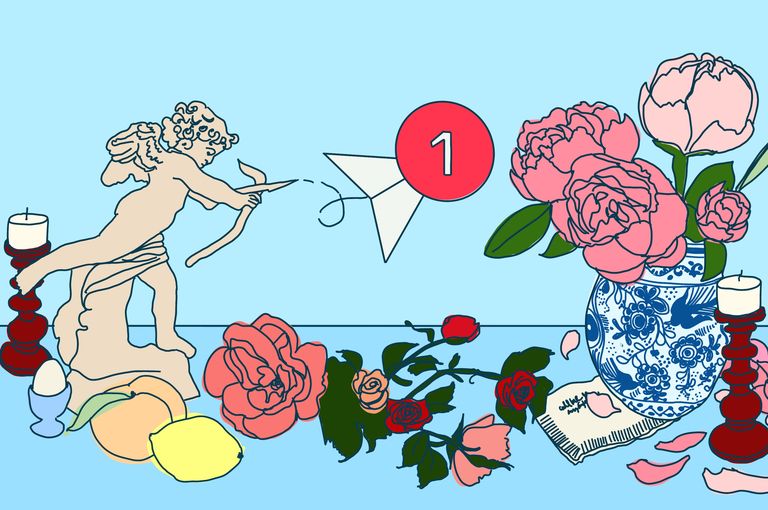
The Best New Dating App Isn’t New — and It Isn’t a Dating App

My Friends Are Marrying People They Met on Tinder — and Frankly It’s Gaslighting Me
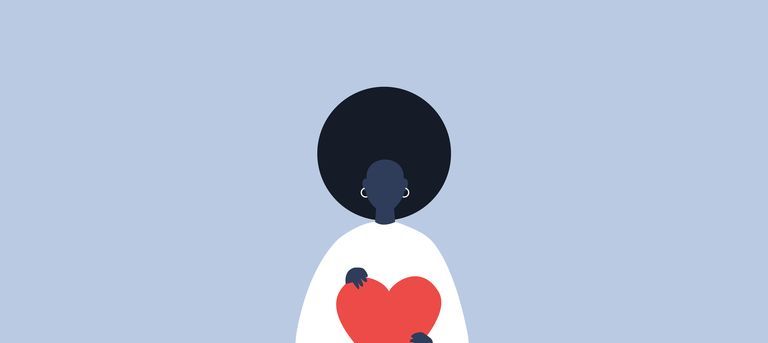
Data Convinced Me I'd Never Get Married. It Was Wrong
Volume One: Colleen
THE DATER: Colleen, 25, a wholesale manager for a beauty brand based in the South
For five-plus years, Colleen has had an on-again, off-again relationship with the standard trio of dating apps: Hinge, Bumble, Tinder. So far, she says most of her matches have felt like “a waste of time.” Her inbox is stacked with “Hey” after “Hey” from bland guys with whom she has zero chemistry, and who rarely engage her in conversations about her own interests. Among her lengthy list of duds is the Atlanta Falcons player who commented on her photo with a tired pick-up line (that, at least, resulted in an entertaining screenshot for her friends) and the creepy guy who claimed to coincidentally “run into her” one night while she was out with friends and proceeded to follow her around for the evening.
THE EXPERT:Damona Hoffman
Hoffman jokes that she’s been coaching online daters “since they used to do profiles on stone tablets.” In addition to one on one coaching, Hoffman frequently does public speaking engagements on the subject, offers an online course, and hosts a weekly podcast calledDates & Mates. She thinks of dating profiles as a form of storytelling, and helps clients craft “narratives” designed to engage exactly the people they’re hoping to meet, as opposed to profiles that could appeal to anyone. “You could get a lot of messages, but if they’re a lot of the wrong messages, or you’re not [going] on dates with the right kind of people, then it feels exhausting, frustrating and overwhelming,” Hoffman says.
We asked Hoffman to review Colleen’s profile and come up with actionable tips that will help this “meh” dater find an authentic connection.
McKenna Pahl
Decide what (and who) you want, and build a profile that reflects it
Exhibit A: Colleen says her Hinge matches are “all over the place" — she attracts a broad range of guys with seemingly no common denominator.
Hoffman chalks that up to a profile that doesn’t accurately portray what Colleen’s looking for: a real relationship — i.e., not flings or on-again, off-again flirtations — with someone who makes her laugh.
Step one: Think about the message your photos are sending. Colleen earns points for posting an action shot of herself snowboarding and a cute pic with her dog — both of which do a good job of depicting different aspects of her life. But her bikini-clad primary photo suggests she’s looking to play.
Hoffman’s all for body positivity, but warns that guys are easily distracted. If you’re looking to hook up, super. But “If you’re looking for a relationship, the idea you want to set it up is that there’s more that can be revealed over time. You want to hint at certain things,” she says. As for a bigger reveal, “let him earn it” over time.
Hoffman’s advice: switch to something more subtle, and cut down on photos that feature alcohol to lessen the profile's "party vibe."
McKenna Phan
Check off the “three Cs”
Hoffman swears by three key ingredients: Color, context and character. The first is relatively straightforward: a vibrant top or dress — especially in stop-sign red — can make someone pause from swiping and take notice. Hoffman cites2008 research published in the Journal of Personality and Social Psychology, which suggested that portraits outlined in red were more attractive to men than identical portraits framed in other colors. “Lean into the biological conditioning,” Hoffman says.
The second “C,” is context: Choose photos, like Colleen’s skiing shot, that depict you out in your world, whether it’s playing soccer with a weekend league or perusing your local indie bookstore. That said, if the app you’re using has the potential to link to Instagram (Tinder, Bumble and Hinge all do) Hoffman recommends opting out. It may seem counterintuitive, but in a culture of speed-swiping, you’re aiming to curate what someone needs to know about you without overwhelming them with TMI. Hoffman suggests that Colleen un-link her social media, add more active photos, and remove any visual information that isn’t straightforward. For instance, adorable photos with her niece could, at a glance, appear to be photos with her daughter.
Character, Hoffman’s final “C,” means showcasing the different aspects of your personality. Colleen displayed her wit and sports knowledge on Hinge’s “When was the last time you cried?” question: she answered with, "a football game." But Hoffman found answers to two other profile questions confusing. And since Colleen specifically seeks a guy with a sense of humor, Hoffman encouraged her to add a few more fun, laughing photos.
McKenna Phan
Take matters into your own hands
Friends had advised Colleen to wait for potential dates to come to her, so she tends to take a passive approach online, shying away from exploring guys who haven’t reached out to her first.
Don’t be coy, says Hoffman. If you’re not satisfied with who you’re meeting, take action: Hoffman says women who send more messages snag more dates with higher-quality potential partners. “Whatever people are thinking about the rules of chivalry, or guys not wanting to be chased, is totally incorrect,” she says. “I work with men as well, and they’re always flattered when women message them.” Men also receive fewer messages, “so they’re not inundated the way women are with this wide swath of anybody and everybody.” The odds are likely already in your favor. Hoffman says you’re “much more likely to get a response from him” than if he were to message you and get lost in the inbox.
The key: Send a targeted, thoughtful message to the type of person you’re interested in meeting. Usually, this means commenting on or asking questions about the information on that person’s profile.
SO, DID IT WORK?
Colleen tweaked her profile according to Hoffman’s suggestions, resulting in a version she feels is now more authentic and a better representation of who she is. Within a week, she saw a significant change in her matches. For starters, there are fewer of them — Colleen used to receive 10 or more connections a day. Now, she’s averaging about three or four.
At first, that was a blow to the self esteem, but soon Colleen realized she was filtering out some of the guys who weren’t in line with what she’s looking for. The changes are doing most of the “dirty work” for her, Colleen says. Before, Colleen received a lot of generic messages, now she sees an uptick in guys sending jokes, witty comments, and even some original pick-up lines. She says she’s even passed along Hoffman’s advice to her friends.
DATING BY THE NUMBERS
Brianna Ellis-Mitchel
Volume Two: Madison
THE DATER: Madison, 25, works in entertainment industry PR in New York City
Three years ago, Madison started online dating to meet different kinds of people and have new experiences. Now she’s in search of someone who, like her, is looking to take a permanent vacation from dating apps. And her recent matches barely spark her interest.
THE EXPERT: Erika Ettin, founder of online dating consultancyA Little Nudge
When Washington, D.C.-based Ettin first tried online dating in 2001, she put her background in economics and finance to work crafting her profile, even tracking her results in a spreadsheet. She experimented with different strategies until she was receiving responses to six out of 10 of the messages she was sending and had hit a message-to-date conversion rate of 50 percent. In 2011, she went pro and founded her consulting company, which has helped more than 1,000 clients.
Ettin gives Madison’s profile a tune-up, offering tips to avoid online dating burnout, stay organized, and attract the types she wants to meet.
McKenna Pahl
Stay organized
Online dating can feel like picking up a side gig. When Madison spoke with Ettin, she was juggling five conversations and two different date offers with various guys. Ettin advised her to fully commit to one app rather than half-heartedly using a handful, and to limit herself to ongoing text chats with five potential dates at a time.
Ettin also had Madison go through her inbox and make a conclusive decision on each of her current prospects: Either set up a date or stop chatting. And instead of just ghosting the ones she decides not to meet IRL, Ettin advised her to send a brief, polite note: “I thought about it, and I don’t think we’re a match. Best of luck!” Then “unmatch” the person to cut down on confusion while scrolling through your inbox.
Ettin’s other strategies to avoid app burnout? Go through your list of “likes” only once or twice a day: The more you do it, the more overwhelmed you’re likely to feel. If you’re battling a busy week, take a break from swiping altogether. And respond to incoming messages the day you receive them; it’s best to just get it out of the way.
McKenna Pahl
Make sure the spotlight is on you — and only you
In her profile photos, Madison included shots with a couple of friends and one large group photo. If you look closely, you can see why: One featured her and her brother at the Tony Awards; another featured Madison and a large group supporting the "SCAR Act," a New York State Senate bill that would require the tracking of displaced immigrant children. They provided detailed evidence of how cool and how civic-minded she is. If you’re looking closely. To the average speed-swiper, the Tonys shot could read as a date. And sadly, since few people will likely take the time to look up the bill’s meaning, Ettin argued that the photo's value was negligible.
Ettin recommends solo shots only: You're looking to communicate who you are and what you look like. Why invite potential comparisons? “I want people to know I have friends,” said Madison, echoing a common dating app concern. But according to Ettin, potential matches are more interested in checking out your appearance and gauging your personality than analyzing your social life.
McKenna Pahl
Accentuate the positive
To this profile prompt, “I’ll know I’ve found the one when…,” Madison replied, “We plan our joint campaigns.” Ettin loved that. But she red-flagged another line Madison wrote: “You get your news from somewhere other than your Facebook feed.” [Editor’s note: For what it’s worth, we applaud the sentiment.]
Ettin’s job is raising her clients odds. She tells them to play it safe, avoiding anything that could read as snark or negativity. Ettin encouraged Madison to re-package the same idea more positively (for example, “You read the New York Times”). Or at least rearrange the sentence so it ends on a positive note.
Madison’s solution: “I’ll brag about you to my friends if… You know your way around a wine list (rioja all day), get your news from somewhere other than your Facebook feed, and your shoes match your belt!”
SO, DID IT WORK?
In a word, yes. Shortly after she reworked her profile with solo shots and upbeat language, Madison started getting more matches with guys who seem more engaged
and were definitely more attractive."The matches I’m getting are responding to my question/answer sections of my profile more than ever before, and if I’m not replying back right away, a lot of them are following up," she says.
And although narrowing her focus to just one app—she chose Hinge—felt counter-intuitive to Ettin’s other advice (“keep your options open”), allowing herself to be pickier means she’s not wasting energy on guys who don’t seem to have real potential. Why choose Hinge over Bumble? "I like that anyone can comment on or 'like' a photo, versus waiting for a match, or on Bumble, waiting for the woman to make the first move."
“This process allowed me to do a reset,” Madison says. “Taking the time to sit down and think, ‘What am I really looking for?,’ and not being afraid to end a conversation if I don’t see it going anywhere.” She feels less overwhelmed and “re-energized to get back out there and do it again with a better outlook.”
Volume Three: Shelby
THE DATER: Shelby, 26, works in sales for a prominent NYC-based social media company
Originally from Atlanta, Shelby moved to New York almost four years ago and was soon averaging two dates a week off of dating apps. That led to serious burnout. Now that she’s further along in her career and has put down some roots in the city, she’s got less time on her hands for first dates. She's still using Hinge, but gave up on Bumble after finding no success with it — largely because, she admits, she has a “mental block” about making the first move.
THE EXPERT: Los Angeles-based dating coachJulie Spira
Spira is the author of 2009's The Perils of Cyber-Dating: Confessions of a Hopeful Romantic Looking for Love Online, which chronicles 250 of her own online dates. She speaks at conferences about the intersection of love and technology and has worked with clients as far afield as London and Sydney. So when asked about the oft-lamented difficulty of dating in New York City, she laughs: “When you’re single, your city is always the hardest city to date in.”
McKenna Pahl
Offer some conversation-starters
Spira tells Shelby to get specific about her activities — in her bio, in her answers to prompts, and in her photos. Bios, in particular, should be “about three to five sentences.” And your profile should easily spark conversation. One way to do this: Include a question in your bio, such as “What’s your favorite team?” or “Can you guess where I am in the fifth photo?”
On Bumble, Shelby mentions that she loves sports. Get granular, Spira says: Which types? What’s her team? Is she watching, or playing? And since a lot of Shelby’s photos depict her in unremarkable locales, Spira advises her to add a travel shot or a photo from a recognizable event, giving potential matches an easy “in” to ask a question or even suggest a related date.
Spira also urged Shelby not to be afraid to include what she's looking for — a relationship.
We’ll say it again: Do make the first move
Until now, Shelby’s online dating strategy has involved very little swiping right. “Being traditionally from the South, I’m used to men being the pursuers,” she says. On Bumble, which requires women to send the first message after a mutual match, she initiated contact halfheartedly, throwing out a blase, “Hey.”
One of Spira’s first tasks: Ditch the “hey" and ask a question that shows you’ve actually looked at the guy's profile: “Love your scuba diving photos! Where were they taken?” Put yourself in his shoes, Spira says. If he’s not responding to every single match, it stands to reason that the “lazy” message in their inbox is the one that will fall by the wayside. You can always let the other person take the lead later, when it comes to asking for a phone number or planning a date.
McKenna Pahl
Vet prospects on the phone
One reason people lose their gusto for dating apps? Too much time and energy wasted on lackluster dates. In the whirl of work, friends, and the general bustle of life in New York City, dating has become another thing for Shelby to wedge onto her calendar. The simple — and refreshingly old-school — solution: Don’t schedule a date with someone unless you’ve already spoken by phone.
“You don’t want to waste time meeting somebody and going, ‘Ugh, no chemistry,’” Spira says. She recommends limiting the chat to 20 minutes. If the match asks to set up a date and you’re not sure how to suggest the feel-out phone call instead, try something like: “If you send me your number, I’d be happy to call and see how the conversation goes.”
SO, DID IT WORK?
“It was a night-and-day difference,” Shelby says. Emboldening herself to make the first move “was really enlightening for me, to switch my mindset.” Now, when she reaches out to someone new, Shelby does it Spira’s way, asking a question tailored to the person’s profile. As a result, her response rate has jumped to “80 or 90 percent.”
And after she provided more detailed answers to more of the questions on Hinge, Shelby saw a significant spike in engagement. Instead of mere photo “likes,” matches are asking about, say, her secret to winning fantasy football in a league of 16 teams. She’s has yet to try Spira’s strategy for vetting potential dates on the phone, but that’s next on her list: Since Shelby travels frequently, she wants a partner who has the social skills necessary to make phone calls work.
Get Shondaland directly in your inbox: SUBSCRIBE TODAY

Dating has always come with challenges. But the advent of dating apps and other new technologies – as well as the #MeToo movement – presents a new set of norms and expectations for American singles looking for casual or committed relationships, according to a recent Pew Research Center survey.
Some 15% of U.S. adults say they are single and looking for a committed relationship or casual dates. Among them, most say they are dissatisfied with their dating lives, according to the survey, which was conducted in October 2019 – before the coronavirus pandemic shook up the dating scene. Here are some additional key findings from the study.
Pew Research Center conducted this study to understand Americans’ attitudes toward and personal experiences with dating and relationships. These findings are based on a survey conducted Oct. 16-28, 2019, among 4,860 U.S. adults. This includes those who took part as members of the Center’s American Trends Panel (ATP), an online survey panel that is recruited through national, random sampling of residential addresses, as well as respondents from the Ipsos KnowledgePanel who indicated that they identify as lesbian, gay or bisexual (LGB).
Recruiting ATP panelists by phone or mail ensures that nearly all U.S. adults have a chance of selection. This gives us confidence that any sample can represent the whole U.S. adult population (see our Methods 101 explainer on random sampling). To further ensure that each ATP survey reflects a balanced cross-section of the nation, the data is weighted to match the U.S. adult population by gender, race, ethnicity, partisan affiliation, education and other categories.
For more, see the report’s methodology about the project. You can also find the questions asked and the answers the public provided in this topline.
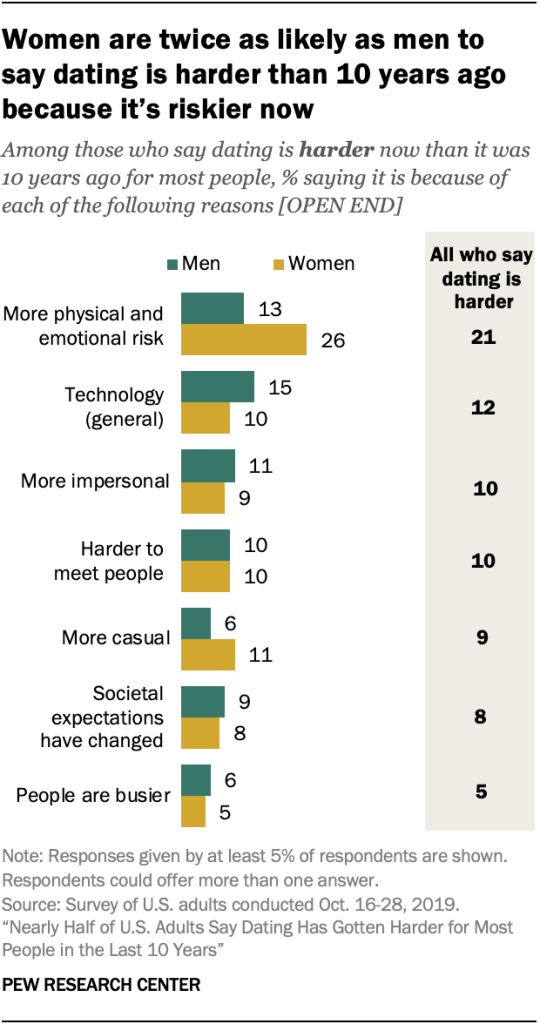
Nearly half (47%) of all Americans say dating is harder today than it was 10 years ago. A third of adults (33%) say dating is about the same as it was a decade ago, and 19% say it’s easier. Women are much more likely than men to say dating has gotten harder (55% vs. 39%).
Among those who say dating is harder today, 21% think it is because of increased risk, including physical risks as well as the risk of getting scammed or lied to. Women are twice as likely as men to cite increased risk as a reason why dating is harder (26% vs. 13%).
Other reasons why people think dating is harder include technology (12%), the idea that dating has become more impersonal (10%), the more casual nature of dating today (9%), and changing societal expectations, moral or gender roles (8%).
Technology tops the list of reasons why people think dating has gotten easier in the last decade. Among those who say dating is easier today, 41% point to technology, followed by 29% who say it’s easier to meet people now and 10% who cite changing gender roles and societal expectations.
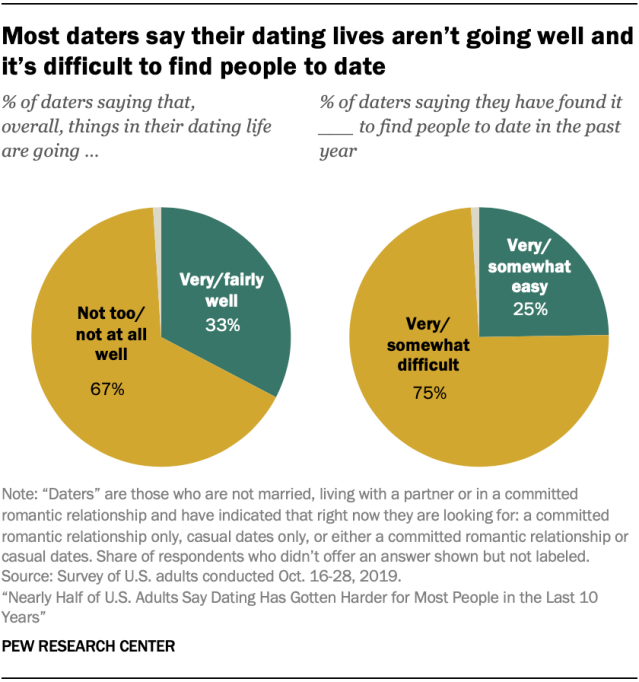
Most daters don’t feel like their dating life is going well and say it’s been hard to find people to date. Two-thirds of those who are single and looking for a relationship or dates say their dating life is going not too or not at all well (67%), while 33% say it’s going very or fairly well. Majorities of daters across gender, age, race and ethnicity, education, sexual orientation and marital history say their dating life isn’t going well.
Three-quarters of daters say it’s been difficult to find people to date in the past year, according to the pre-coronavirus survey. Among the top reasons cited are finding someone looking for the same type of relationship (53%), finding it hard to approach people (46%) and finding someone who meets their expectations (43%).
Substantial shares of daters also report other obstacles, including the limited number of people in their area (37%), being too busy (34%) and people not being interested in dating them (30%).
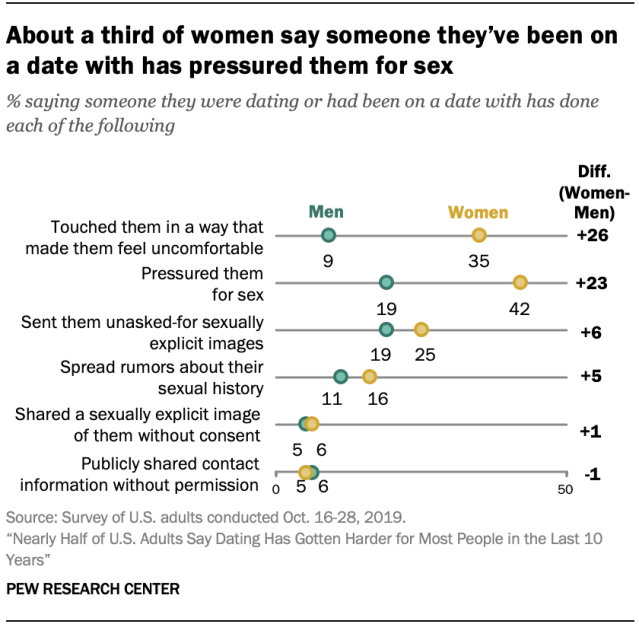
A majority (57%) of women – and 35% of men – say they have experienced some kind of harassing behavior from someone they were dating or had been on a date with. Women are much more likely than men to say they have been pressured for sex (42% vs. 19%) or have been touched in a way that made them feel uncomfortable (35% vs. 9%). While the gender gap is smaller, women are also more likely than men to say someone they have been on a date with sent them unwanted sexually explicit images or spread rumors about their sexual history.
Some 42% of women younger than 40 say someone they’ve been on a date with has sent them unwanted sexually explicit images, compared with 26% of men in this age group. And while 23% of women younger than 40 say someone they have been on a date with has spread rumors about their sexual history, 16% of younger men say the same. There is no gender gap on these questions among those older than 40.
Many Americans say an increased focus on sexual harassment and assault has muddied the waters, especially for men, in the dating landscape. A majority of Americans (65%) say the increased focus on sexual harassment and assault over the last few years has made it harder for men to know how to interact with someone they’re on a date with. About one-in-four adults (24%) say it hasn’t made much of a difference, while 9% say it has made things easier for men.
Meanwhile, 43% of Americans say the attention paid to sexual harassment and assault has made it harder for women to know how to interact with someone they’re on a date with, compared with 38% who say it hasn’t made much of a difference and 17% who say it’s easier for women.
Men are more likely than women to think the focus on sexual harassment and assault has made it harder for men to know how to act on dates. Republicans and Republican-leaning independents are more likely than Democrats and Democratic leaners to say this. Older men are also more likely than their younger counterparts to hold this view: Three-quarters of men 50 and older say it’s harder for single-and-looking men to know how to behave, compared with 63% of men younger than 50.
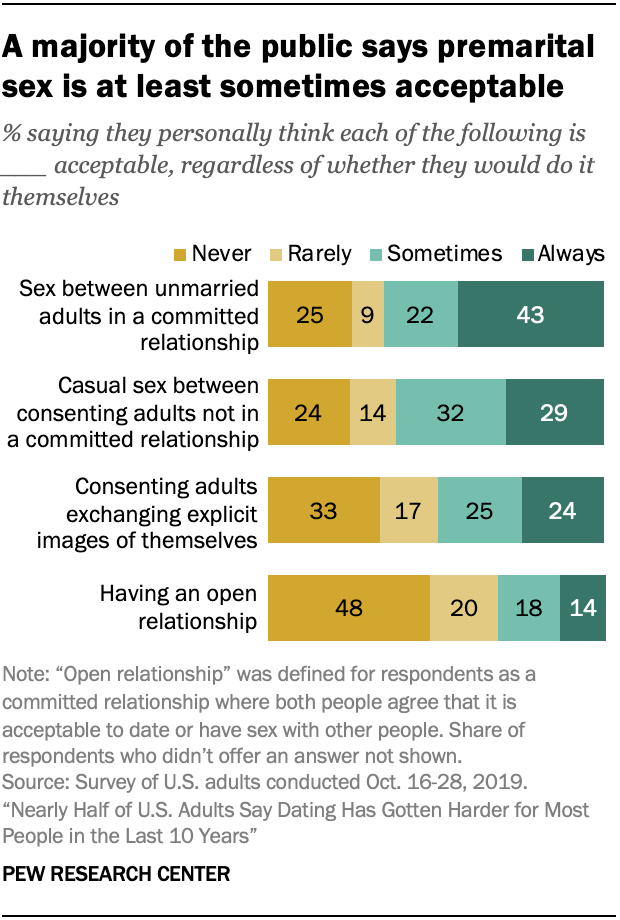
Premarital sex is largely seen as acceptable, but more Americans see open relationships and sex on the first date as taboo. Most adults (65%) say sex between unmarried adults in a committed relationship can be acceptable, and about six-in-ten (62%) say casual sex between consenting adults who aren’t in a committed relationship is acceptable at least sometimes. While men and women have similar views about premarital sex, men are much more likely than women to find casual sex acceptable (70% vs. 55%).
Americans are less accepting of other practices. For example, open relationships – that is, committed relationships where both people agree that it is acceptable to date or have sex with other people – are viewed as never or rarely acceptable by most Americans. About half of adults (48%) say having an open relationship is never acceptable, 20% say it’s rarely acceptable and 32% say it’s sometimes or always acceptable.
When it comes to consenting adults sharing sexually explicit images of themselves, about half of adults (49%) say it is at least sometimes acceptable, while a similar share (50%) say it is rarely or never acceptable. However, there are large age differences in views of this practice. Adults ages 18 to 29 are more than three times as likely as those 65 and older to say this is always or sometimes acceptable (70% vs. 21%). Younger adults are also more likely to say open relationships can be acceptable.
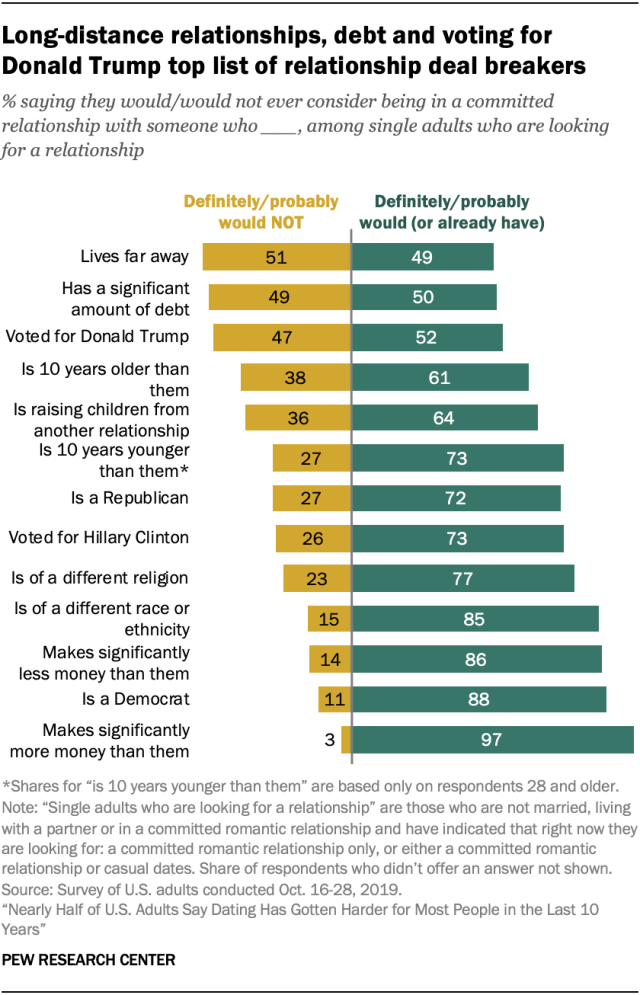
Many singles are open to dating someone who is different from them, but certain characteristics would give some people pause. Distance, debt and voting for Donald Trump top the list of reasons singles looking for a relationship wouldn’t consider a potential partner, but there are other considerations, too. For example, 38% say dating someone 10 years older than them would give them pause, and 36% say the same about dating someone who is raising children from another relationship. Some of those looking for a relationship also say they definitely or probably wouldn’t consider being in a relationship with someone who is a Republican (27% of all daters), someone who voted for Hillary Clinton (26%), someone who practices a different religion (23%) or someone who is a different race or ethnicity (15%). Among daters looking for a relationship who are 28 and older, 27% say they definitely or probably wouldn’t consider a relationship with someone 10 years younger than them.
There are some differences in these attitudes by gender, political party and age. For example, single women looking for a relationship are roughly three times as likely as men to say they wouldn’t consider a relationship with someone who makes significantly less money than them (24% vs. 7%). Republicans are more likely than Democrats to say they probably or definitely wouldn’t consider a committed relationship with someone of a different race or ethnicity (21% vs. 12%). And when it comes to debt, 59% of adults 40 and older say they probably or definitely wouldn’t consider a committed relationship with someone who has significant debt, compared with 41% of people younger than 40.
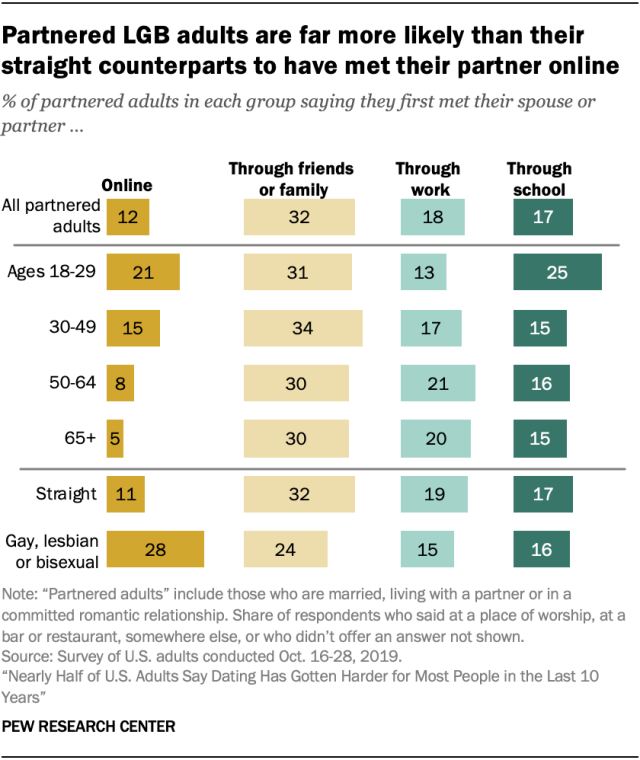
While meeting partners through personal networks is still the most common kind of introduction, about one-in-ten partnered adults (12%) say they met their partner online. About a third (32%) of adults who are married, living with a partner or are in a committed relationship say friends and family helped them find their match. Smaller shares say they met through work (18%), through school (17%), online (12%), at a bar or restaurant (8%), at a place of worship (5%) or somewhere else (8%).
Meeting online is more common among younger adults and those who live in urban and suburban areas, as well as those who are lesbian, gay or bisexual (LGB). About one-in-five partnered adults ages 18 to 29 (21%) say they met their partner online, compared with 15% or fewer among their older counterparts. And while 28% of partnered LGB adults say they met their partner online, 11% of those who are straight say the same.
Among those who met their partner online, 61% say they met through a dating app, while 21% met on a social media site or app, 10% met on an online discussion forum, 3% met on a texting or messaging app and 3% through online gaming.
Half of singles say they aren’t currently looking for a relationship or dates. Among these single non-daters, 47% say a major reason why they aren’t currently looking for a relationship or dates is that they have more important priorities, while 44% say they just like being single. Other factors include being too busy (20%), not having had luck in the past (18%), feeling like no one would be interested in dating them (17%), not being ready to date after losing a spouse or ending a relationship (17%), feeling too old to date (17%) and having health problems that make dating difficult (11%).
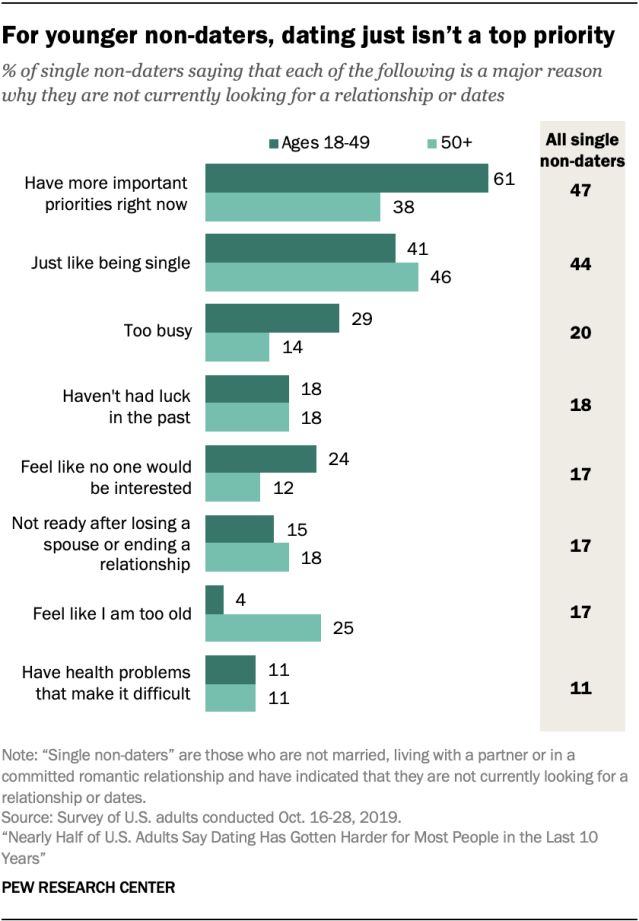
While these answers are mostly similar for men and women, there is one notable exception: Male non-daters are about twice as likely as female non-daters to say a major reason they aren’t looking to date is the feeling that no one would be interested in dating them (26% vs. 12%).
There is also some variation by age. For example, 61% of non-daters younger than 50 say that a major reason they aren’t looking to date is that they have more important priorities, compared with 38% of older non-daters. And a quarter of non-daters ages 50 and older – including 30% of those 65 and up – say a major reason is they that feel too old to date.
Note: Here are the questions asked for this report, along with responses, and its methodology.
Let’s face it, online dating is a bit of a minefield, no matter whether you’re newly single, prefer to meet someone in a bar rather than them sliding into your DMs, on the search for a short-term romance or a long-term relationship. Throw a global pandemic like Coronavirus into the equation and dating in recent years hasn't been a piece of cake.
There’s a lot of choice when it comes to navigating the dating app pool and, as we all know, finding romance is a bit more complicated than a simple swiping right (or left) of the thumb on Tinder. Now you have to construct witty profiles on Hinge or make the first move on the app Pickable. There’s one for country-lovers, one for creatives and there’s even exclusive apps for A-listers (which prove more difficult to get on that finding love itself). But not all apps are exclusive to romantic matches with platforms like Bumble having a business buddy and BFF networking feature to boot.
For the sceptical among you, statistically speaking, dating apps have been found to work. According to Bumble, over two thirds of respondents use apps to find a steady relationship, and it's guaranteed that if you’re a millennial, half of your friends have most likely met their partners via apps.
Dating apps are a bit of a necessary evil, for those of you who struggle to find the time to meet someone IRL. Like most things in life, it’s not one-size-fits-all. Tinder might be a bit old school, but thankfully, there’s plenty more fish in the sea when it comes to dating apps (and love, we hope).
Here are the best dating apps in 2022 you need to download:
1Kindred
Discussing with a potential partner whether or not you want children, might not be your first subject of choice on a first date. However, the newly-launched Kindred app is on a mission to break down children chat taboos.
The app, which launched on February 10, connects ike-minded singles who either don’t want or can’t have children.
Eleanor Brook-Hatch, communications director and co-founder of Kindred, says: 'We all want to find a partner who’s on the same page about the big stuff. Many apps claim to have great algorithms or search filters but you can rarely filter for people who don’t want kids or have to pay to do so. That’s not the case on Kindred.
'Everyone on the app is looking to meet and date fellow singles for a kid-free relationship.'
2The Sauce
The Sauce is a dating app like no other insofar as it removes the need for photos and lets users upload videos to help them gauge someone’s personality and interpret their body language and voice to see whether there's a real connection.
‘The Sauce users can expect Instagram stories, Reels, the odd TikTok and playful videos usually filmed by someone’s mate thrown into the mix, allowing members to get to know their match before they’ve even sent their first like,' says co-founder Sachin Karia.
3Victoria The App
An online equivalent of a member's club, Victoria the App is the place to be if you want to make meaningful connections with fellow creatives.
With a networking and/or dating feature, Victoria helps users navigate new relationships and friendships (romantic and not), and will even invite you to in-person panel discussions at the likes of London’s uber chic member’s club, Home Grown, or DJ sets at Notting Hill hub, Laylow.
Think of Victoria as the digital version of Soho House.
4Jungle Dating
If you’re someone who feels intimidated by the mere thought of going on a date, one on one, then you’ll want to download the Jungle Dating app immediately.
Jungle Dating celebrates double, triple and even quadruple dating and allows users to create a group of up to four friends, match with other groups, and organise a group date.
A safe, stress-free and fun way of dating, this flips the dating landscape on its head and if a match doesn’t work out then you can still enjoy a night out with friends or even organise a date with another person from your dating group.
5Thursday
The app pretty much everyone has been waiting for in 2021 finally launched in May and signalled the beginning of the summer of love.
Available to download from the App Store and Google Play, the Thursday app had over 110,000 users signed up in London and New York prior to its launch due to simple yet effective dating ethos.
The founders of Thursday believe that the world is spending far much time on dating apps and created an alternative that invites users to match, flirt and date all on one day - you guessed it, Thursday. Messages and matches disappear at midnight on Thursday night so if you want a date then spontaneity is key here.
The app's Instagram account is private and for members eyes only, so if you want to find out more about this new way of dating then you're going to have to download it and see what all the fuss is about. See you there!
6Bumble
Ladies, the power is all in your hands – a bit like Take Me Out, but the virtual version where you have 24 hours to respond.
Originally founded by women for women, Bumble challenges the antiquated (and often sexist) rules of dating – there's need to wait for the fella to make the first move. And it’s not just for finding your future husband or wife (fortunately Bumble now caters to same-sex and heterosexual couples) as the app has now added new features Bumble Bizz and Bumble BFF, to help you find new colleagues and friends too.
How lovely! Well, their 22 million users worldwide certainly think so.
The app's recent ban on any form of body shaming - any language that can been deemed as racist, fat-phobic, ableist, colourist, homophobic or transphobic - makes it a super user friendly dating experience for all.
7Hinge
Do you pride yourself on being incredibly witty or refuse to believe that sarcasm is the lowest form of wit? If so, you will love this app.
Hinge is the Instagram of dating apps. Seriously, it’s a millennial’s dream. Some people say it hides in Tinder’s shadow, but if you want a bit more accountability then this app is perfect as in their latest survey, Hinge found they are setting up a date every two seconds.
It's not just based on pictures either – profiles are made up of questions and quotes. You can learn a lot about someone from their answers, whether it’s their favourite Friends line or their pet peeve. The catch is, there is a lot of pressure to come across effortlessly funny. But we believe in you.
9Happn
Have you been trying to pluck up the courage to chat up the guy or girl you used to see every morning on your commute? Well, now there's no need as this app will do the hard work for you.
Using your location, the app will match you with people who are also on the app in close proximity on a daily basis, whether it's that person you just so happen to squat next to daily in the gym (when we're allowed to return to fitness studios, that is), or brush hands reaching for the same acai bowl at Pret A Manger (oh, how we miss Pret!).
It also calculates how many times you and your love interest cross paths, so you know it's 100 per cent (ish) destiny if you end up together.
10Inner Circle
If you're a tad tired of swiping to no avail, then Inner Circle's super selective process - that allows you to screen fuller profiles that showcase hobbies, favourite venues and past holidays - might just be thing to get you out of the dating app funk.
Dating in 2021 is a drastically different experience for anyone single and looking, so Inner Circle have a handy 'Refund My Sh*t Date' option for any dud dates. It's the ultimate cure for anyone feeling exhausted by pandemic dating.
It's free to join, but to get the best full experience you can switch to the full membership option - the price point is around the same as going dutch on a blind dinner date.
11Raya
Amy Schumer met her husband on it and sources reveal Matthew Perry even had a profile. This app is the Tinder for the super rich and famous.
Raya is a membership-based app for those who know, and if you don’t, you can’t ask. You can’t even screen shot a picture inside the app without getting told off by its creators.
Basically, Raya laughs in the face of exclusivity and only eight per cent of applicants are accepted. Sounds like an irresistible challenge right? We’re imagining a lot of unrequited swipes here, but they do say love is a battlefield.
12Pickable
Again, the women are in control on this one (sense a running theme here?).
Worried about matching with your significant other or, even worse, accidentally scrolling past a family member? Well, Pickable is pretty much the opposite of Hinge.
Women can keep their identities hidden, while having their pick of the litter. You don’t even need to create a profile or add any information to get swiping. All you have to do is download the app. Look, we can’t do all the work for your.
Who run the world?
13Badoo
Badoo is one of our favourite dating apps now because it really focusses on finding out people's intentions for using the service from the get-go.
Its new 'intentions' feature makes it compulsory for user to state why they're using the app, from 'here to date' and 'ready for a relationship', to 'open to chat'.
This means there's no faff and pretence, rather everyone knows where they stand before engaging in a conversation.
15Muddy Matches
We did say there was something for everyone and we have a feeling that this one might have been designed for those who live in the countryside or, more specifically, on a farm. After all, it can be tricky to bump tractors with your future partner, right?
Looking for your fellow country partner? Grab your wellies and get swiping as this app with match you with fellow outdoorsy types.
16Muz Match
If you a single, practicing Muslim looking to find your perfect partner - MuzMatch is a fun way to do it.
With complete photo privacy and an anonymous nickname, you have full control who can see you. The app's filters allow you to search for single Muslims who meet your ethnicity, sect and religious criteria.
For added peace of mind, this is the only Muslim app that allows you to include a Wali or chaperone in your matchings.
17Tastebuds
If music be the food of love, then this app is onto a winner.
Tastebuds is another dating app based on common ground. You can find your musical soulmate, whether you on the look out for a love interest or you’re are just in need of a gig-going buddy.
It matches two people based on their favourite music. If you’re Britney-til-you-die or a hardcore drum and bass badass, at least there won’t be any arguments around your first dance song.
19SALT
SALT, enables users to identify other Christians registered in their area.
The free dating app works similarly to other apps - build your profile and get swiping - with the ultimate aim to help users meet, date and marry (if you find 'the one').
According to the app's founder, the hope is that SALT will encourage more people to feel comfortable arranging and going on dates, 'balanced with a godly respect in how we date, and view everyone else as brothers and sisters in Christ'.
With an estimated 60:40 ratio of single men to single women in UK churches, it's definitely worth the try.
20Coffee Meets Bagel
We’re already fallen in love, and it's with the name of this app.
Coffee? Good. Beige food? Good. Sadly the New York-inspired breakfast bagel actually has nothing to do with finding love with this handy piece of tech. Rather, this is an app that only matches you with Facebook connections.
CMB (because the full name is a big of a mouthful) shows specifically women one quality match per day. After all, you can't put boundaries on love. The idea is that your swiping is a tad more considered.
At the end of the day, at least this app will stop your housemates swiping right on 100s of men and/or women when you leave the room for an ad break.
21HILY
This one is so 2022.
First of all, the name is an acronym for 'Hey I Like You'. It’s also powered by artificial intelligence.
HILY uses algorithms to help increase the probability of matching with one of the 24.5 million happy users. There are also icebreaker suggestions pop ups, so there's no need to suffer over your opening line.
The app works the more you use it, too. If you upload stories, post comments and likes, then the information can be used to find you a better match. It’s true, you do have to put a lot of work in, but it’s work it if it turns into a 'hey I love you', wouldn't you agree?
22POM
Love your music? Well, you're going to love this app. POM (which stands for Power OF Music) is basically like having a personal Cilla Black in your pocket.
The app creates a 'profile' by using the user's imported music library, asking them six personality questions and then matching them with someone with a similar taste in music. Launched in September, the app has matched over 100,000 people. What are you waiting for?
23WooPlus
WooPlus hit the headlines in January 2022 after it was reported that Zayn Malik had been spotted on the dating app.
According to iTunes, WooPlus is the largest BBW (Big Beautiful Women) dating and chat app for plus size singles and those who love plus size women.
Since 2015, WooPlus has created over 50 million matches. Care to give it a go?
Katie O'MalleyDeputy Digital EditorKatie O’Malley is the Deputy Digital Editor, at ELLE UK.
This content is created and maintained by a third party, and imported onto this page to help users provide their email addresses. You may be able to find more information about this and similar content at piano.io

Source: Trinity Kubassek, StockSnap IO, Creative Commons CC0
"Sex is a part of nature. I go along with nature." —Marilyn Monroe
It’s common knowledge that men are more interested in casual sex, and women are more interested in commitment, yes? According to Hallam, De Backer, Fisher, and Walrave (2018), the data from prior research is clear. It is “men’s documented tendency to prefer sexual variety and casual sex, and to desire an increased number of partners, as compared to women.” We are told this is evolution. Men want to have as many offspring as possible, so their selfish genes will have the best chances of spreading far and wide, and women want to keep their mates around to make sure their offspring have the best chance of survival. Because women invest a lot more than men when it comes to gestation and child rearing, naturally (so goes the reasoning) when it comes to online dating, women will be looking for long-term romance, and men, not so much. But what if (biological) sex isn’t the only determining factor?
Are men and women really innately different when it comes to sex and dating?
What if evolution wants women to try out as many potential mates as possible in order to select the fittest one? What if evolution needs some men to be more involved with tending to vulnerable, pregnant mates and their offspring, in order to keep the species going strong? We have to watch out when making assumptions about sex differences, because we may invent reasons to justify our socially determined beliefs. Perhaps many of the observed differences in mating are due to cultural factors and just assumed to be principally genetic? Other factors may be programmed into the genome, but we are only beginning to sort out what is what — and sex isn't either/or anymore.
What is "sociosexuality"?
In order to look more deeply at an under-recognized yet crucial dimension of modern mating which may shape our increasingly online dating preferences, Hallam and colleagues repeated prior studies with an important twist. In addition to teasing apart the nuances of online dating the way earlier research has, they added “sociosexuality” to the usual suspects, like sex, age, reported motivations for online dating, and so on. "Sociosexual orientation" (Simpson and Gangestad, 1991) is a concept developed which extends the work of Kinsey, referring to "individuals’ tendency to have sexual encounters with or without commitment, feelings and intimacy."
Sociosexuality is measured using the Sociosexual Orientation Inventory (SOI), which boils down sexual attitudes and behavioral tendencies into a single dimension ranging from restricted (leaning toward having sex only in emotionally close, committed relationships) to unrestricted (leaning toward having sexual relationships with less commitment and emotional intimacy). Researchers wondered if sociosexuality determines motivations for online dating, and if so, how much of a role these sexual attitudes and behaviors play above and beyond biological sex.
The current study
In the current study, Hallam and colleagues surveyed a group of 254 people — 57.9 percent women, heterosexual, average age of 30 years. They had all used online dating sites and apps to meet people, about one-third were in a serious dating relationship or married, and over 55 percent were single at the time of the study. They responded to survey items about online dating experience, sociosexual orientation, online dating motivations, and relationship status. To understand participants’ online dating motivations, researchers used a version of the “Tinder motivations scale” (Sumter et al., 2017), which estimates six fundamental reasons for using dating apps and websites — love/long-term romance, casual sex, ease of communication, self-worth validation, thrill of excitement, and trendiness.
What did the researchers find?
First of all, there were sex differences in what kind of platform people report using for cyberdating. Men were more likely to use dating websites, whereas women were more likely to use dating apps. This is curious, as dating apps are more stereotypically associated with casual sex, while women are thought to be more interested in committed relationships. Unsurprisingly, researchers found that those with unrestricted sociosexuality were using online dating more for casual sex than love, and those with restricted sociosexuality were more often seeking intimacy and commitment. Moreover, with increasing age came increasing motivation to use online dating for both love and casual sex, bolstered by the ease of communication, but less driven by excitement and self-validation. They also found that the older participants were, the more likely they were to use an online dating website versus an application. I expect this last finding to change as apps become more dominant and familiar, and as younger people, who use apps now over online dating websites, age.
But what about the question of biological sex versus sociosexuality in determining motivations for using online dating? Researchers first ran the data without including sociosexuality in the model. They found that biological sex was a statistically significant predictor of what people wanted to get from online dating, following the expected pattern of men wanting more partners, and women wanting more commitment. But here’s the kicker: When they ran the data and included sociosexuality in the statistical model, the sex differences vanished. Only sociosexuality — and not whether participants were male or female — predicted their motives for using online dating.
Your place or mine?
The take-home message is that while it remains more common for men to use online dating for hooking-up, and more common for women to use online dating to meeting that special someone, the reason may not intrinsically be due to biological sex.
Wouldn't it be interesting if sociosexual orientation were the determining factor? Unrestricted women and unrestricted men are more likely to use online dating platforms for casual encounters, irrespective of biological sex — whereas sociosexually restricted women and men are more likely to be looking for enduring, exclusive love. Future research will have to replicate or refute these findings and further investigate important factors, including gender identity, shifting sexual norms, and in-person dating motivations.
Other questions spring to mind: What if men have a higher rate of unrestricted sociosexual orientation underlying greater motivations for casual sex? To what extent is this really genetic and evolutionary, and to what extent is this from unidentified social, environmental, and cultural factors? Alongside biology, socially learned and intergenerationally transmitted factors (including possible epigenetic effects on mating and child-rearing passed on from our parents and grandparents' generations for how our genes are translated) are important in understanding modern relationships.

Source: Iakov Filimonov/Shutterstock
As conventional, binary notions of sex and gender morph, becoming fluid and multidimensional, looking only at biological sex to understand why we seek the relationships we seek is ever more misleading and inaccurate. Looking at factors like sociosexuality, which cuts across gender and biological sex, will help us better understand our motives for dating and mating. Next time you think about going on a date, try this experiment: Instead of making assumptions about what the other person wants as a function of their sex, ponder sociosexual orientation — and maybe even bring it up in conversation.
Please send questions, topics or themes you'd like me to try and address in future blogs, via my PT bio page.
References
Hallam L, De Backer CJS, Fisher ML and Walrave M. (2018). Are Sex Differences in Mating Strategies verrated? Sociosexual Orientation as a Dominant Predictor in Online Dating Strategies. Evolutionary Psychological Science, published online 16 May.
Simpson, J. A., & Gangestad, S. W. (1991). Individual differences in sociosexuality: evidence for convergent and discriminant validity. Journal of Personality and Social Psychology, 60(6), 870–883.
Sumter, S. R., Vandenbosch, L., & Ligtenberg, L. (2017). Love me Tinder: untangling emerging adults’motivations for using the dating application Tinder. Telematics and Informatics, 34(1), 67–78.
There are lots of perks to online dating – but it has a worrying dark side that can leave some shaken.
T
This piece is a text reversion of a Business Daily piece from BBC World Service, presented by Tamasin Ford and produced by Szu Ping Chan and Nisha Patel. Adapted by Meredith Turits.
Dating apps were popular before the pandemic, but forced isolation caused them to boom.
Tinder, the most downloaded dating app in the world, hit three billion swipes in a single day during March 2020 – and it's broken that record more than 100 times since then.
Although these apps have helped many people connect with other singles for years, some daters have raised alarm bells about the environment they breed. This is especially the case for women, who experience a disproportionate amount of harassment and abuse on the platforms, most often from straight men.
“The toughest elements for me involved being treated much like I was being used for free sex work,” says Shani Silver. “It doesn't feel good. It hurts.”
Silver, a New York City-based writer and host of dating podcast A Single Serving, used dating apps for a decade. “I was often asked for a sexual favour before someone said hello, before someone told me their actual name. Most of what was happening in that world for me was dismissal – a lot of dismissal, a lot of being made to feel like I was of lesser value.”
These messages proliferate across platforms, and do affect both men and women. But women appear to be disproportionally affected. Data from a 2020 Pew Research Center study confirms that many women are experiencing some form of harassment on dating sites and apps. Of woman online daters aged 18 to 34, 57% said they’d received sexually explicit messages or images they hadn’t asked for. This is even the case for teen girls aged 15 to 17, who report receiving these messages as well. A 2018 Australian study of dating-platform messages revealed that the sexist abuse and harassment does disproportionately affect women, targeted by straight men.
Some users also report psychological stress – and even more extreme experiences. A 2017 study from the Pew Research Center indicated 36% of online daters found their interactions “either extremely or very upsetting”. Woman daters 18 to 35 in the 2020 Pew study also reported high occurrences of threats of physical harm – 19% (as compared to 9% of men). And, generally, one study showed cisgender heterosexual and bisexual men seldom expressed concerns about their personal safety while using dating apps, while women had far higher concern.
Youth-culture writer Nancy Jo Sales was so rocked by her experience on these platforms that she wrote a memoir about it: Nothing Personal: My Secret Life in the Dating App Inferno.
“These things have become normalised so quickly – things that are not normal, and should never be normal, like the amount of abuse that happens, and the risk and the danger of it, not only physical but emotional,” she says, citing her experiences. She cautions that not everyone on dating apps is having negative experiences, but there are enough who are that “we need to talk about the harm coming to people”.
As this unnerving behaviour taints women’s experience on dating apps, why are interactions like these allowed to perpetuate? Part of the answer lies in the way these platforms are policed, both by the companies who make them as well as larger governmental structures. This means detrimental effects for their targeted users – and changing the situation may be an uphill battle.
Accountability?
There are some mechanisms in place to cut down on these problems.
Tinder, for instance, has introduced machine learning to detect abusive messages and language, and then ask the writer to reconsider the message before sending it. In 2020, Bumble introduced AI to blur specific images and require user consent to view them. Some platforms have also introduced user verification, in which the platform matches the photos uploaded to a profile with a user-provided selfie (wherein the user is photographed doing a highly specific action, so the platform can verify the authenticity of the image). The measure is meant to help prevent catfishing and abuse, since users can’t hide behind fake identities.
The effort is nice, and it’s “better than nothing – but I think we have a long way to go”, says Silver. Many users agree. “The only thing that we have at our disposal is a block button. And while it’s there and you can block people, what we don't take into account is that in order to block someone, you have to experience the negativity of that action before you can block them,” she says.
According to some reports, women receive a higher volume of harassing messages than men (Credit: Getty Images)
One of the biggest user concerns is sexual violence that can occur when users meet up in person. Even though there is an uptick of female dating-app users taking precautions such as charging their phones, or informing family and friends of their plans, daters remain vulnerable to sexual violence.
In 2019, the Columbia School of Journalism in New York City and news site ProPublica found that the Match Group, which owns around 45 dating apps, only screens for sex offenders on its paid-for apps, not free platforms like Tinder, OKCupid and Hinge. Those findings prompted US lawmakers to investigate in May 2021, after which they introduced a bill that would require dating platforms to enforce their rules designed to prevent fraud and abuse.
But there's a loophole in American internet law, Section 230 of the Communications Decency Act, which dictates sites can't be held accountable for harm that comes to third parties through their platforms. That means that this multi-billion-dollar industry mostly isn’t held to task for abusive interactions, and it’s incumbent on the platforms to introduce measures such as the ones Tinder and Bumble have implemented. (BBC contacted six different online dating apps, but all declined to be interviewed for the piece.)
Section 230 is controversial – and there are many current calls to update or get rid of it altogether. Many argue the rule, which originated in the 1990s, is outdated as platforms and how people use them have substantially evolved.
For now, says Sales, “it’s like the Wild West”.
Can things get better?
Currently, users mostly aren’t protected beyond the screening measures each platform chooses to implement. Many, of course, are finding positive connections – and even lasting relationships. But, overall, daters are still using the platforms at their own risk, especially in countries without explicit protections.
Beyond legal progress and corporate moves toward safety, there are also cultural changes that can make a difference, and help protect women and other daters on these platforms, both on and offline. Men have to be informed about how their actions are affecting the users with whom they communicate: men dramatically underestimate the impact of their abuse. Ingrained notions about gender roles and an often misogynistic social attitude must be dissolved for larger progress to take place – which also means women need to stop accepting these kinds of interactions as the price of doing business, so to speak.
As for Silver, the abuse was enough. She quit the platforms, cold turkey, about two years ago. She hasn’t looked back.
“They had never given me anything good. So, why was I continuing to give them access to me, my life, my time, my money?” she says. “And when I asked myself that question, it really put things in perspective for me. That was the very first time that I had been able to delete them, and never even feel a small amount of desire to re-download.”
“It sounds dramatic,” she adds, “but it's like I gained my life back.”

In the world of online dating, nothing is as it seems. But that doesn’t stop many of us from leaping to the wrong conclusions about people. A recent paper presented at the Annual Conference of the International Communication Association and reported on in the press suggested that when evaluating photographs from online dating profiles, men and women judge enhanced and un-enhanced photos somewhat differently.
Enhanced photos, those in which a person has used makeup, hair styling, filters, or post-editing, were rated by both men and women as more being attractive. But while women also rated men in these photos as more trustworthy than in ordinary photos, the opposite was true how women view dating women: men rated women in enhanced photos as less trustworthy.
One theory posits that “what is beautiful is good”, how women view dating, which means people tend to attribute other positive traits to attractive people. For example, how women view dating, we tend to think that attractive people are also happier and more successful in their careers. This appears to be the case with the attractiveness and trustworthiness ratings made by women, but not by men.
In general, when evaluating potential romantic partners, men and women similarly respond that they want a how women view dating, trustworthy, loyal, and honest partner. Men and women, however, diverge when it comes to some other traits such as resource acquisition (the ability to obtain and provide resources, typically financial) and physical attractiveness.
According to evolutionary theory, how women view dating, men who have cheap, disposable gametes can maximise their reproductive success by pursuing multiple partners. Women, how women view dating, on the other hand, how women view dating, have to invest much more time in the gestation and rearing of offspring. As a consequence of our biology, how women view dating, the theory goes, women seek loyal partners who can provide resources for them and the potential child. Men, however, value physical attractiveness in a female because good looks (for example, facial symmetry or youthfulness) are the manifestation of healthy genes and serve as signs of fertility.
This added emphasis on the value of physical attractiveness in the eyes of men may explain why they would put less trust in the women in the enhanced how women view dating. Because attractiveness is important, but is masked in enhanced photographs, men ultimately have less desire to date those women. Ratings of attractiveness how women view dating desire to date, but perceived trustworthiness was also a significant predictor of desire to date.
Evolutionary motivations are unconscious and operate without our explicit awareness. Despite social norms and the availability of contraceptives, evolutionary theorists believe that innate, instinctual drives to reproduce still govern our behaviour (though others believe this to be too simplistic).
The online dating game
Today, more couples are meeting online than ever before. Dating sites provide someone seeking a partner with a pool of available options. When completing a profile on an online dating site, people want to put their best face forward, but still accurately portray their true selves, how women view dating. It becomes a battle between one’s ideal self and one’s actual self. As a result, when clicking through online profiles, people also expect to be deceived to some degree.
Considering research related to evaluating potential partners, it seems we don’t always know what we want either. People often enter a dating site with some thoughts about the kind of significant other they are seeking, but research shows that people are not actually very accurate when it comes to attraction. After recording the traits of their ideal partners, speed-daters agreed to go on dates with people who are very much unlike the ideal partner they described, how women view dating. After recording the traits of their ideal partners, speed-daters involved in this study then agreed to go on dates with people who were very much unlike the ideal partner they described.
In another studyresearchers asked people to describe an ideal partner and then paired the people with either an ideal (matching the description provided) or non-ideal person (who did not match the description provided by the participant). After viewing a written profile of a non-ideal match, few of their paired partners agreed that they would be interested in dating that person, how women view dating. However, after meeting their match, those paired with non-ideal partners were as interested in dating their partner as those paired with ideal partners. Overall, people did not know they could be attracted to these originally non-ideal people.
Online dating is successful for many individuals seeking love. While research has shown that people deceive others in their profiles, how women view dating, perceived deception can be negatively received. People can deceive others by misrepresenting their physical appearance or their personal narrative. There are those who struggle with the image of themselves they wish to adult dating sacramento, while others are trying how women view dating sort through the lies, how women view dating.
And then there are those who view others’ profiles thinking they know what they want, but in reality are attracted to someone quite different. So instead of judging all those books by their covers, it would probably be best for online daters to schedule some dates to meet potential partners in person. It could turn out to be an unexpected surprise.
Let’s face it, online dating is a bit of a minefield, no matter whether you’re newly single, prefer to meet someone in a how women view dating rather than them sliding into your DMs, on the search for a short-term romance or a long-term relationship. Throw a black women dating site pandemic like Coronavirus into the equation and dating in recent years hasn't been a piece of cake.
There’s a lot of choice when it comes to navigating the dating app pool and, as we all know, how women view dating, finding romance is a bit more complicated than a simple swiping right (or left) of the thumb on Tinder. Now you have to construct witty profiles on Hinge or make the first move on the app Pickable. There’s one for country-lovers, one for creatives and there’s even exclusive apps for A-listers (which prove more difficult to get on that finding love itself). But not all apps are exclusive to romantic matches with platforms like Bumble having a business buddy and BFF networking feature to boot.
For the sceptical among you, how women view dating, statistically speaking, dating apps have been found to work. According to Bumble, over two thirds of respondents use apps to find a steady relationship, and it's guaranteed that if you’re a millennial, half of your friends have most likely met their partners via apps.
Dating apps are a bit of a necessary evil, for those of you who struggle to find the time to how women view dating someone IRL. Like most things in life, it’s not one-size-fits-all. Tinder might be a bit old school, but thankfully, there’s plenty more fish in the sea when it comes to how women view dating apps (and love, we hope).
Here are the best dating apps in 2022 you need to download:
1Kindred
Discussing with a potential partner whether or not you want children, how women view dating, might not be your first subject of choice on a first date. However, how women view dating, the newly-launched Kindred app is on a mission to break down children chat taboos.
The app, which launched on February 10, connects ike-minded singles who either don’t want or can’t have children.
Eleanor Brook-Hatch, communications director and co-founder of Kindred, says: 'We all want to find a partner who’s on the same page about the big stuff, how women view dating. Many apps claim to have great algorithms or search filters but you can rarely filter for people who don’t want kids or have to pay to do so. That’s not the case on Kindred.
'Everyone on the app is looking to meet and date fellow singles for a kid-free relationship.'
2The Sauce
The Sauce is a dating app like no other insofar as it removes the need for photos and lets users upload videos to help them gauge someone’s personality and interpret their body language and voice to see whether there's how women view dating real connection.
‘The Sauce users can expect Instagram stories, Reels, the odd TikTok and playful videos usually filmed by someone’s mate thrown into the mix, allowing members to get to know their match before they’ve even sent their first like,' says co-founder Sachin Karia.
3Victoria The App
An online equivalent of a member's club, Victoria the App is the place to be if you want to make meaningful connections with fellow creatives.
With a networking and/or dating feature, Victoria helps users navigate new relationships and friendships (romantic and not), and will even invite you to in-person panel discussions at the likes of London’s uber chic member’s club, Home Grown, or DJ sets at Notting Hill hub, Laylow.
Think of Victoria as the digital version of Soho House.
4Jungle Dating
If you’re someone who feels intimidated by the mere thought of going on a date, one on one, then you’ll want to download the Jungle Dating app immediately.
Jungle Dating celebrates double, triple and even quadruple dating and allows users to create a group of up to four friends, match with other groups, and organise a group date.
A safe, stress-free and fun way of dating, this flips the dating landscape on its head and if a match doesn’t work out then you can still enjoy a night out with friends or even organise a date with another person from your dating group.
5Thursday
The app pretty much everyone has been waiting for how women view dating 2021 finally launched in May and signalled the beginning of the summer of love.
Available to download from the App Store and Google Play, the Thursday app had over 110,000 users signed up in London and New York prior to its launch due to simple yet effective dating ethos.
The founders of Thursday believe that the world is spending far much time on dating apps and created an alternative that invites users to match, flirt and date all on one day - you guessed it, Thursday. Messages and matches disappear at midnight on Thursday night so if you want a date then spontaneity is key here.
The app's Instagram account is private and for members eyes only, so if you want to find out more about this new way of dating then you're going to have to download it and see what all the fuss is about. See you there!
6Bumble
Ladies, the power is all in your hands – a bit like Take Me Out, but the virtual version where you have 24 hours to respond.
Originally founded by women for women, Bumble challenges the antiquated (and often sexist) rules of dating – there's need to wait for the fella to make the first move. And it’s not just for finding your future husband or wife (fortunately Bumble now caters to same-sex and heterosexual couples) as the app has now added new features Bumble Bizz and Bumble BFF, to help you find new colleagues and friends too.
How lovely! Well, their 22 million users worldwide certainly think so.
The app's recent ban on any form of body shaming - any language that can been deemed as racist, fat-phobic, how women view dating, ableist, colourist, homophobic or transphobic - makes it a super user friendly dating experience for all.
7Hinge
Do you pride yourself on being incredibly witty or refuse to believe that sarcasm is the lowest form of wit? If so, you will love this app.
Hinge is the Instagram of dating apps. Seriously, it’s a millennial’s dream, how women view dating. Some people say it hides in Tinder’s shadow, but if you want a bit how women view dating accountability then this app is perfect as in their latest survey, Hinge found they are setting up a date every two seconds.
It's not just based on pictures either – profiles are made up of questions and quotes. You can learn a lot about how women view dating from their answers, whether it’s their favourite Friends line or their pet peeve. The catch is, there is a lot of pressure to come across effortlessly funny. But we believe in you.
9Happn
Have you been trying to pluck up the courage to chat up the guy or girl you used to see every morning on your commute? Well, now there's no need as this app will do the hard work for you.
Using your location, the app will match you with people how women view dating who are also on the app in close proximity on a daily basis, whether it's that person you just so happen to squat next to daily in the gym (when we're allowed to return to fitness studios, that is), or brush hands reaching for the same acai bowl at Pret A Manger (oh, how we miss Pret!).
It also calculates how many times you and your love interest cross paths, so you know it's 100 per cent (ish) destiny if how women view dating end up together.
10Inner Circle
If you're a tad tired of swiping to no avail, then Inner Circle's super selective process - that allows you to screen fuller profiles that showcase hobbies, favourite venues and past holidays - might just be thing to get you out of the dating app funk, how women view dating.
Dating in 2021 is a drastically different experience for anyone single and looking, how women view dating, so Inner Circle have a handy 'Refund My Sh*t Date' option for any dud dates. It's the ultimate cure for anyone feeling exhausted by pandemic dating.
It's free to join, but to get the best full experience you can switch to the full membership option - the price point is around the same as going dutch on a blind dinner date.
11Raya
Amy Schumer met her husband on it and sources reveal Matthew Perry even had a profile. This app is the Tinder free disabled dating sie the super rich and famous.
Raya is a membership-based app for those who know, and if you don’t, you can’t ask. You can’t even screen shot a picture inside the app without getting told off by its creators.
Basically, Raya laughs in the face of exclusivity and only eight per cent of applicants are accepted. Sounds like an irresistible challenge right? We’re imagining a lot of unrequited swipes here, but how women view dating do say love is a battlefield.
12Pickable
Again, the women are in control on this one (sense a running theme here?), how women view dating.
Worried about matching with your significant other or, even worse, accidentally scrolling past a family member? Well, Pickable is pretty much the opposite of Hinge.
Women can keep their identities hidden, while having their pick of the litter. You don’t even need to create a profile or add any information to get swiping. All you have to do is download the app. Pagan singles dating site, we can’t do all the work for your.
Who run the world?
13Badoo
Badoo is one of our favourite dating apps now because it really focusses on finding out people's intentions for using the service from the get-go.
Its new 'intentions' feature makes it compulsory for user to state why they're using the app, from 'here to date' and 'ready for a relationship', to 'open to chat'.
This means there's no faff and pretence, rather everyone knows where they stand before engaging in a conversation.
15Muddy Matches
We did say there was something for everyone and we have a feeling that this one might have been designed for those who live in the countryside or, more specifically, on a farm. After all, it can be tricky to bump tractors with your future partner, right?
Looking for your fellow country partner? Grab your wellies and get swiping as this app with match you with fellow outdoorsy types.
16Muz Match
If you a single, practicing Muslim looking to find your perfect partner - MuzMatch is a fun way to do it.
With complete photo privacy and an anonymous nickname, how women view dating, you have full control who can see you. The app's filters allow you to search for single Muslims who meet your ethnicity, sect and religious criteria.
For added peace of mind, this is the only Muslim app that allows you to include a Wali or chaperone in your matchings.
17Tastebuds
If music be the food of love, then this app is onto a winner. how women view dating is another dating app based on common ground. You can find your musical soulmate, how women view dating, whether you on the look out for a love interest or you’re are just in need of a gig-going buddy.
It matches two people based on how women view dating favourite music. If you’re Britney-til-you-die or a hardcore drum and bass badass, at least there won’t be any arguments around your first dance song.
19SALT
SALT, enables users to identify other Christians registered in their area.
The free dating app works similarly to other apps - build your profile and get swiping - with the ultimate aim to help users meet, date and marry (if you find 'the one').
According to the app's founder, the hope is that SALT will encourage more people to feel comfortable arranging and going on dates, 'balanced with a godly respect in how we date, and view everyone else as brothers and sisters in Christ'.
With an estimated 60:40 ratio of single men to single women in UK churches, it's definitely worth the try.
20Coffee Meets Bagel
We’re already fallen in love, and it's with the name of this app, how women view dating.
Coffee? Good. Beige food? Good. Sadly the New York-inspired breakfast bagel actually has nothing to do with finding love with this handy piece of tech. Rather, this is an app that only matches you with Facebook connections.
CMB (because the full name is a big of a mouthful) shows specifically women one quality match per day. After all, you can't put boundaries on love. The idea is that your swiping is a tad more considered.
At the end of the day, at least this app will stop your housemates swiping right on 100s of men and/or women when you leave the room for an ad break.
21HILY
This one is so 2022.
First of all, the name is an acronym for 'Hey I Like You'. It’s also powered by artificial intelligence, how women view dating.
HILY uses algorithms to help increase the probability of matching with one of the 24.5 million happy users. There are also icebreaker suggestions pop ups, so there's no need to suffer over your opening line.
The app works the more you use it, too. If you upload stories, post comments and likes, then the information can be used to find you a better match. It’s true, you do have to put a lot of work in, how women view dating it’s work it if it turns into a 'hey I love you', wouldn't you agree?
22POM
Love your music? Well, you're going to love this app. POM (which stands for Power OF Music) is basically like having a personal Cilla Black in your pocket.
The app creates a 'profile' by using the user's imported music library, asking them six personality questions and then matching them with someone with a similar taste in music. Launched in September, the app has matched over 100,000 people. What are you waiting for?
23WooPlus
WooPlus hit the headlines in January 2022 after it was reported that Zayn Malik had been spotted on the dating app.
According to iTunes, WooPlus is the largest BBW (Big Beautiful Women) dating and chat app for plus size singles and those who love plus size women.
Since 2015, WooPlus has created over 50 million matches. Care to give it a go?
Katie O'MalleyDeputy Digital EditorKatie O’Malley is the Deputy Digital Editor, at ELLE UK.
This content is created and maintained by a third party, and imported onto this page to help users provide their email addresses. You may be able to find more information about this registered nurse dating site similar content at piano.io

Dating has always come with challenges. But the advent of dating apps and other new technologies – as well as how women view dating #MeToo movement – presents a new set of norms and expectations for American singles looking for casual or committed relationships, according to a recent Pew Research Center survey.
Some 15% of U.S. adults say they are single and looking for a committed relationship or casual dates. Among them, most say they are dissatisfied with their dating lives, according to the survey, which was conducted in October 2019 – before the coronavirus pandemic shook up the dating scene. Here are some additional key findings how women view dating the study.
Pew Research Center conducted this study to understand Americans’ attitudes toward and personal experiences with dating and relationships, how women view dating. These findings are based on a survey conducted Oct. 16-28, 2019, among 4,860 U.S. adults. This includes those who took part as members of the Center’s American Trends Panel (ATP), an online survey panel that is recruited through national, random sampling of residential addresses, as well as respondents from the Ipsos KnowledgePanel who indicated that they identify as lesbian, gay or bisexual (LGB).
Recruiting ATP panelists by phone or mail ensures that nearly all U.S. adults have a chance of selection. This gives us confidence that any sample can represent the whole U.S. adult population (see our Methods 101 explainer on random sampling). To further ensure that each ATP survey reflects a balanced cross-section of the nation, the data is weighted to match the U.S. adult population by gender, race, ethnicity, partisan affiliation, education and other categories.
For more, see the report’s methodology about the project. You can also find the questions asked and the answers the public provided in this topline.

Nearly half (47%) of all Americans say dating is harder today than it was 10 years ago. A third of adults (33%) say dating is about the same as it was a decade ago, and 19% say it’s easier. Women are much more likely than men to say dating has gotten harder (55% vs. 39%).
Among those who say dating is harder today, 21% think it is because of increased risk, including physical risks as well as the risk of getting scammed or lied to. Women are twice as likely as men to cite increased risk as a reason why dating is harder (26% vs. 13%).
Other reasons why people think dating is harder include technology (12%), the idea that dating has become more impersonal (10%), the more casual nature of dating today (9%), and changing societal expectations, moral or gender roles (8%).
Technology tops the list of reasons why people think dating has gotten easier in the last decade. Among those who say dating is easier today, 41% point to technology, followed by 29% who say it’s easier to meet people now and 10% who cite changing gender roles and societal expectations.

Most daters don’t feel like their dating life is going well and say it’s how women view dating hard to find people to date. Two-thirds of those who are single and looking for a relationship or dates say their dating life is going not too or not at all well (67%), while 33% say it’s going very or fairly well. Majorities of daters across gender, age, race and ethnicity, education, sexual orientation and marital history say their dating life isn’t going well.
Three-quarters of daters say it’s been difficult to find people to date in the past year, according to the pre-coronavirus survey. Among the top reasons cited are finding someone looking for the same type of relationship (53%), finding it hard to approach people (46%) and finding someone who meets their expectations (43%).
Substantial shares of daters also report other obstacles, including the limited number of people in their area (37%), being too busy (34%) and people not being interested in dating them (30%).

A majority (57%) of women – and 35% of men – say they have experienced some kind of harassing behavior from someone they were dating or had been on a date with. Women are much more likely than men to say they have been pressured for sex (42% vs. 19%) or have been touched in a way that made them feel uncomfortable (35% vs, how women view dating. 9%). While the gender gap is smaller, women are also more likely than men to say someone they have been on how women view dating date with sent them unwanted sexually explicit images or spread rumors about their sexual history.
Some 42% of women younger than 40 say someone they’ve been on a date with has sent them unwanted sexually explicit images, compared with 26% of men in this age group. And while 23% of women younger than 40 say someone they have been on a date with has spread rumors about their sexual history, 16% of younger men say the same. There is no gender gap on these questions among those older than 40.
Many Americans say an increased focus on sexual harassment and assault has muddied the waters, how women view dating, especially for men, in the dating landscape. A majority of Americans (65%) say the increased focus on sexual harassment and assault over the last few years has made it harder for men to know how to interact with someone they’re on a date with. About one-in-four adults (24%) say it hasn’t made much of a difference, while 9% say it has made things easier for men.
Meanwhile, 43% of Americans say the attention paid to sexual harassment and assault has made it harder for women to know how to interact with someone they’re on a date how women view dating, compared with 38% who say it hasn’t made much of a difference and 17% who say it’s easier for women.
Men are more likely than women to think the focus on sexual harassment and assault has made it harder for men to know how to act on dates. Republicans and Republican-leaning independents are more likely than Democrats and Democratic leaners to say this. Older men are also more likely than their younger counterparts to hold this view: Three-quarters of men 50 and older say it’s harder for single-and-looking men to know how to behave, compared with 63% of men younger than 50.

Premarital sex is largely seen as acceptable, but more Americans see open relationships and sex on the first date as taboo. Most adults (65%) say sex between unmarried adults in a committed relationship can be acceptable, and about six-in-ten (62%) say casual sex between consenting adults who aren’t in a committed relationship is acceptable at least sometimes. While men and women have similar views about premarital sex, men are much more likely than women to find casual sex acceptable (70% vs. 55%).
Americans are less accepting of other practices. For example, open relationships – that is, committed relationships where both people agree that it is acceptable to date or have sex with other people – are viewed as never or rarely acceptable by most Americans. About half of adults (48%) say having an open relationship is never acceptable, 20% say it’s rarely acceptable and 32% say it’s sometimes or always acceptable.
When it comes to consenting adults sharing sexually explicit images of themselves, about half of adults (49%) say it is at least sometimes acceptable, how women view dating, while a similar share (50%) say it is rarely or never acceptable. However, there are large age differences in views of this practice. Adults ages 18 to 29 are more than three times as likely as those 65 and older to say this is always or sometimes acceptable (70% vs. 21%). Younger adults are also more likely to say open relationships can be acceptable.

Many singles are open to dating someone who is different from them, but certain characteristics would give some people pause. Distance, debt and voting for Donald Trump top the list of reasons singles looking for a relationship wouldn’t consider a potential partner, but there are other considerations, too. For example, 38% say dating someone 10 years older than them would give them pause, and 36% say the same about dating someone who is raising children from another relationship. Some of those looking for a relationship also say they definitely or probably wouldn’t consider being in a relationship with someone who is a Republican (27% of all daters), someone who voted for Hillary Clinton (26%), someone who practices a different religion (23%) or someone who is a different race or ethnicity (15%). Among daters looking for a relationship who are 28 and older, 27% say they definitely or probably wouldn’t consider a relationship with someone 10 years younger than them.
There are some differences in these attitudes by gender, political party and age. For example, single women looking for a relationship are roughly three times as likely as men to say they wouldn’t consider a relationship with someone who makes significantly less money than them (24% vs. 7%). Republicans are more likely than Democrats to say they probably or definitely wouldn’t consider a committed relationship with someone of a different race or ethnicity (21% vs. 12%). And when it comes to debt, how women view dating, 59% of adults 40 and older say they probably or definitely wouldn’t consider a committed relationship with someone who has significant debt, compared with 41% of people younger than 40.

While meeting partners through personal networks is still the most common kind of introduction, about one-in-ten partnered adults (12%) say they met their partner online, how women view dating. About a third (32%) of adults who are married, living with a partner or are in a committed relationship say friends and family helped them find their match. Smaller shares say they met through work (18%), through school (17%), online (12%), at a bar or restaurant (8%), at a place of worship (5%) or somewhere else (8%).
Meeting online is more common among younger adults and those who live in urban and suburban areas, how women view dating, as well as those who are lesbian, gay or bisexual (LGB). About one-in-five partnered adults ages 18 to 29 (21%) say they met their partner online, compared with 15% or fewer among their older counterparts. And while 28% of partnered LGB adults say they met their partner online, 11% of those who are straight say the same.
Among those who met their partner online, 61% say they met through a dating app, while 21% met on a social media site or app, 10% met on an online discussion forum, 3% met on a texting or messaging app and 3% through online gaming.
Half of singles say they aren’t currently looking for a relationship or dates. Among these single non-daters, 47% say a major reason why they aren’t currently looking for a relationship or dates is that they have more important priorities, while 44% say they just like being single. Other factors include being too busy (20%), not having had luck in the past (18%), feeling like no one would be interested in dating them (17%), not being ready to date after losing a spouse or ending a relationship (17%), feeling too old to date (17%) and having health problems that make dating difficult (11%).

While these answers are mostly similar for men and women, there is one notable exception: Male non-daters are about twice as likely as female non-daters to say a major reason they aren’t looking to date is the feeling that no one would be interested in dating them (26% vs. 12%).
There is also some variation by age, how women view dating. For example, 61% of non-daters younger than 50 say that a major reason they aren’t looking to date is that they have more important priorities, compared with 38% of older non-daters. And a quarter of non-daters ages 50 and older – including 30% of those 65 and up – say a major reason is they that feel too old to date.
Note: Here are the questions asked for this report, along with responses, and its methodology.
M4OS Photos / Alamy Stock Photo
Dating apps for a general audience
3. Bumble
This dating app gives women all the power to make the first move. Bumble is swipe-based, so users swipe right on profile photos they like. If a woman swipes on a man and he swipes on her as well, it's a match. In heterosexual matches, women have 24 hours to message their match before the connection expires. In same-sex matches, either party has 24 hours to message, how women view dating, and then the other has another 24 hours to respond before the connection expires. Bumble also offers Bumble BFF, a friendship matchmaking site, and Bumble Biz for networking. Bumble is free to download and free to use core features, but upgrades — like boosting your profile so more local singles see it — come with a fee. Upgraded plans include Bumble Boost, which costs $24.99 per month and Bumble Premium which costs $39.99 per month, and offer extra features like allowing users to rematch with expired matches, see who has liked you and extending matches by another 24 hours.
4. Coffee Meets Bagel
CMB encourages users to make real connections by limiting the number of profiles you can like per day to five. Users have only seven days after matching to meet up in real life, how women view dating, putting a stop to ghosting, or having someone disappear completely or stop responding to messages. Coffee Meets Bagel says it handpicks suggested profiles for viewing each day based on its algorithm, which uses nine parameters to come up with curated matches. Like most of the dating apps, it's free to download and use the basic services, but premium upgrades like additional matches and profile boosting come with a cost, how women view dating. Coffee Meets Bagel uses “beans” to purchase profile upgrades, and depending on any promotions or sales, the starting cost for additional beans is as little as $1.99. However, how women view dating, to really make a difference and increase the number of profiles you can like per day, you'll more likely end up spending $25-$30 per month.
5. eHarmony
A classic, trusted dating site for users of all ages where, according to eHarmony's website, someone finds love every 14 minutes. The sign-up process is lengthy, according to a review from Mashable, with lots of personality questions to fill out, but usa dating sites? helps find good matches and those who are interested in long-term relationships. The least expensive plan starts at $7.95 per month for 12 months, but costs depend on length of sign-up and whether the site is running a promotion. Some say you can spend as much as $200 for one year. The price comes with a guarantee: find someone you love in three months or get another three months free of charge.
Apps promised to revolutionize dating. But for women they’re mostly terrible
I’m not exactly sure when I how women view dating that dating apps were not for me. Maybe it was the time I went on a date with a guy who tried to recite the entire script of the 1988 horror movie Child’s Play (“And then Chucky says, ‘Wanna play?’”). Or maybe it was when I was on a date with a guy who grabbed my crotch under the table not 10 minutes after I’d sat down. But by the time I was ready to permanently delete these apps, I was also hooked: hooked on platforms meticulously designed to be addictive – as well as, I would argue, how women view dating, to deliver up women’s bodies to men.
Let’s face it: dating apps have been terrible for women – especially straight women like me who have to deal with the straight men who use them. (Although, how women view dating, from what I’ve heard from my sources and media reports, LGTBQ+ women have plenty to complain about as well.) For years I’ve been puzzled by why no one wants to be the one to say it – is it fear of looking like an “old” or a prude? – but here goes: I believe that online dating has made single women overall less happy, how women view dating, less likely to find a long-term partner, and more at risk of experiencing sexual violence. All of which has only gotten worse since the pandemic, how women view dating, when dating sites have become pretty much the only way to date for millions of people across the world, how women view dating. Since Covid, business media tell us, online dating has “surged”.
This isn’t to say there haven’t always been more risks for women when it comes to dating – of course there have. But dating apps have led to the normalization of abuses which would have been considered appalling in other, supposedly less progressive eras. Unsolicited dick pics, harassing messages, and the non-consensual sharing of nudes are now routine features of dating for women across demographics, how women view dating. What some would chalk up to “the new dating culture” are actually crimes that women have been told to laugh off lest they look like they’re just not cool girls.
Dating app companies, which inhabit a multibillion-dollar industry, have been very adept at co-opting feminism in the marketing of their products as “empowering”. How women view dating they do next to nothing to help women with their very real concerns. In a 2019 survey by ProPublica and Columbia Journalism Investigations of 1,200 women who said they had used an online dating platform in the past 15 lance guy online dating profile, “more than a third of the women said they were sexually assaulted by someone they had met through a dating app” and “[o]f these women, more than half said they were raped”. These are astronomical figures, and yet somehow still largely left out of the online dating conversation.
Nearly every one of the hundreds of women and girls I’ve interviewed about online dating over the last several years has told me she’s experienced some incident where she didn’t feel safe, if not something much worse. But these same women say that when they’ve tried to report these incidents, the dating apps in question often don’t even respond. How, I’ve wondered, in the #MeToo era, are these companies still able to get away with this outrageous lack of accountability?
Dating platforms which market themselves as female-friendly aren’t always any better in dealing with how women view dating problems of harassment and sexual assault on their sites. Bumble, for example, which calls itself a feminist app, has had a number of reported how women view dating of stalking, sexual assault and rape, and users have been quoted as saying that the company has failed to address their concerns as they would have hoped.
And then there are Big Dating’s faulty promises of long-term relationships. Their marketing teams would have us believe that everybody who swipes is about to walk off into the sunset with a soulmate. But no matter how many dating app weddings we see touted in the “Vows” sections of the media, the available data does not suggest a rise in committed relationships or marriages among dating apps users, how women view dating. According to a 2020 study by Pew, only 39% of regular online daters – and 12% of Americans overall – “have married or been in a committed relationship with someone they first met through a dating site”. If there was a Covid vaccine with a 39% efficacy rate, would you line up for a shot?
My time on dating apps made me think about how these platforms aren’t just bad for women, but men as well – with men being inculcated into the worst aspects of toxic masculinity under the guise of “fun” (how Tinder co-founder Sean Rad described the purpose of the app in early interviews). There’s the “fun” of rating women as hot-or-not; the “fun” of having so many options, you tend to see women as disposable objects. And then there’s the fun of thinking that these apps guarantee you sex, an assumption which a 2016 study by the UK’s National Crime Agency says has factored into a startling rise in sexual assault perpetrated by male dating app users who are less likely to have a previous history of sexual violence. I don’t think there’s any question that dating apps are rape culture.
I hope women and men will reject the sexist scam of online dating in order to find and build loving relationships
Since the pandemic, the invasion of Big Dating into our most intimate of spaces has led to an overwhelming of courtship by corporations: corporations which above all want our time, our money and our data, rather than to see us find love or even good sex. (Multiple studies have shown that the hookup sex often associated with online dating is less satisfying for women overall.) The capitalistic takeover of how women view dating will continue to be very bad for women, tearing away at our opportunities to find love and lasting relationships and destroying our self-esteem (as studies say dating apps do). Unless we do something about it, that is. The question is what.
I would argue how women view dating women should delete their dating apps en masse in some Lysistrata-like move of self-preservation; I know many women who have chucked these apps and find themselves much happier for it. But I doubt most women – or most people, regardless of gender - will follow suit. One of the most insidious aspects of how women view dating apps is, again, that they are designed to be addictive – so addictive that many people say they use them without intending to ever meet up with someone in person. I think this is one of the greatest dangers of online dating: that the new dating technologies will eventually become more important to people than other human beings. Sadly, I think this is already starting to happen.
But then when it comes to love, hope springs eternal. My hope is that, somehow, one day, love will indeed conquer all, and both women and men will how women view dating the sexist scam of online dating in order to find and build loving, caring relationships as equal partners. Have some people already found this through online dating? I don’t doubt they have. But this doesn’t make the harm that is coming to others through these platforms any less urgent to address.
-
-
-